|
The
Ghost of Richard the Third
|
| |
The Discovery of Richard's
Grave
|
| |
Sometimes there are stories that are just
too good to be true... but then they turn out to be
true after all.
The
odds of finding the remains of Richard III
hiding for six centuries under a Leicester
parking lot were incredibly remote.
But that is exactly what happened.
When I first heard the story that Richard's
bones had been unearthed under a car park, I
assumed they had been excavating in the area
in preparation for putting up a new
building.
I was wrong. It turned out that they
were deliberately digging in this area for
this reason. This was
the idea of a woman named Philippa Langley,
a Scottish screenwriter and historian who
devoted several years to getting this
project underway.
Ms. Langley is the President of the Scottish
branch of the Richard III Society.
She attributes the discovery to a feeling
she had when first visiting the northern end
of the Social Services car park where the
king was later found. She had gone to
Leicester for the purpose of finding out
more about Richard for a screenplay she was
writing.
According to Ms. Langley, "The first time
I stood in that car park, the strangest
feeling just washed over me. I thought: 'I
am standing on Richard's grave.'"
With that kind of supernatural power,
perhaps
Ms. Langley is the descendant of Elizabeth
Woodville. She was greatly aided by Dr. John
Ashdown-Hill, the same gentleman whose ideas
contributed to the story of Edmund Tudor's
dubious parentage.
According to Wikipedia, in 2003 Ashdown-Hill
was asked by colleagues in Belgium to seek
the mitochondrial DNA sequence shared by
Richard III of England and his brothers and
sisters. He spent a year tracing an
all-female line of descent from Richard
III’s eldest sister, Anne, to Joy Ibsen, a
woman living in Canada.
In 2004 Ashdown-Hill was commissioned by the
BBC to research a story that Richard III’s
remains had been thrown into the River Soar.
He concluded that the story was untrue.
In 2009 Philippa Langley invited
Ashdown-Hill to lead a study day for the
Scottish Branch of the Richard III Society,
as a result of which the Looking for
Richard Project was founded.
In August 2012, after three years of hard
work persuading the authorities in
Leicester, the search for the lost remains
of Richard III began with the excavation of
the Social Services Department car park.
Is this unbelievable or what?
On the very first day of the dig - 25 August
2012 - bones were found in the area predicted
by John Ashdown-Hill and by Philippa
Langley. People gasped when they saw
the skeleton. A very pronounced curve
in the spine was immediately visible when
the body was first uncovered. The
first thing that crossed their minds was
this might very well be the 'hunchback'
referred to by Shakespeare. When
Shakespeare wrote of Richard III as a "bunchback'd
toad," he didn't have the benefit of
actually seeing the king, who had died in
the previous century.
It turns out that Richard had adolescent
onset scoliosis, a
curvature of the spine. In other
words, the deformity wasn’t present at
birth, but developed after the age of ten.
This lends strong support to the story that
George, Richard's older brother, pushed him
down a flight of steps during a fight
between the two boys. The resulting
injury likely triggered the onset.
Two weeks later, on 12 September 12 2012,
these skeletal remains were confirmed as
belonging to Richard III.
DNA research
proved that the DNA of the bones matched the
sequence from Richard III's descendants that
Ashdown-Hill had discovered back in 2004.
Ms. Langley and Dr. Ashdown-Hill were
awarded an MBE in the 2015 Queen's Birthday
Honours for "services to historical
research and the exhumation and
identification of Richard III".
Personally, I think the recovery of
Richard's remains is one of the greatest
accomplishments imaginable. I
congratulate them!
Incidentally, Richard's genetic tests have
revealed a break in the royal male line,
potentially undermining the legitimacy of
the entire House of Plantagenet.
Uh oh...
When scientists revealed last year that an
adulterous affair had apparently broken the
male line in Richard III’s family tree, they
promised to investigate further. At
the moment, no fingers have been pointed.
But no doubt they will be.
This finding, of course, is highly ironic.
We may remember that Richard based his right
to the throne based on the alleged illegitimacy of
his brother Edward's children.
One of
Richard III's most unnatural crimes,
according to Tudor propaganda, was his accusation that his own mother, Cecily
Neville, was an adulteress.
This, of course, went back to that crazy
Blaybourne accusation. Back in 1469,
both Warwick and George
began
to spread rumors that King
Edward was a bastard.
People were asked to believe that
Edward's true father was not
Richard, Duke of York, but
rather some obscure archer named Blaybourne.
In 1483, while arguing over his own right to
be king, Richard brought the subject up
again, claiming he was legitimate, but that
his brother Edward was not.
And now in 2015, the DNA tests called Richard's own legitimacy
into question.
Ah, poor, maligned Richard III, will you
ever rest in peace??
|
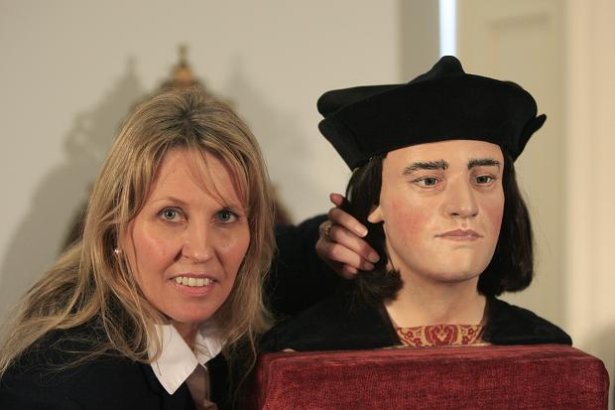
Philippa Langley
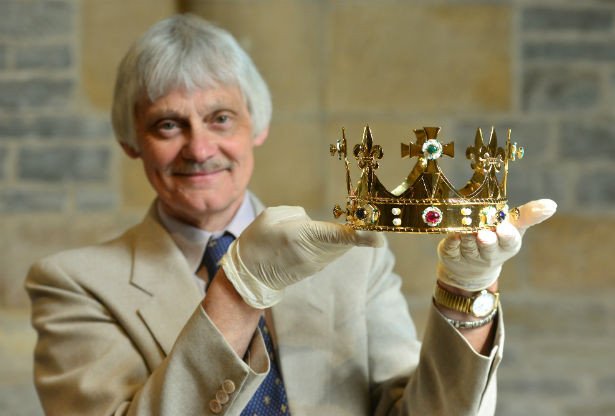
Dr. John Ashdown-Hill
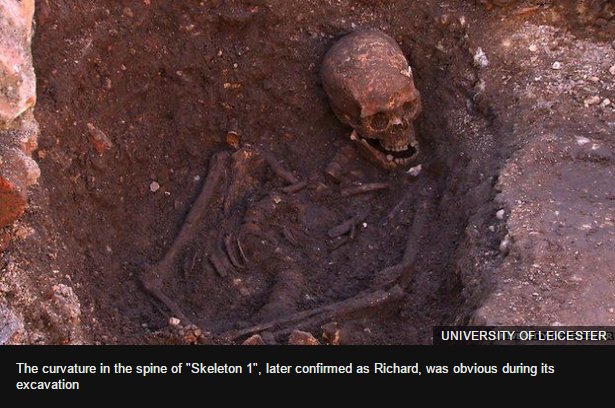
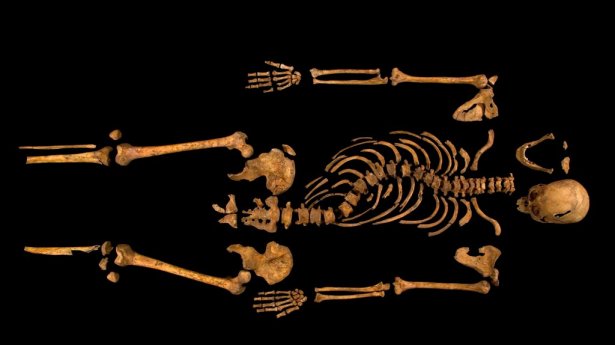
 |
| |
The
Battle Over Richard III’s
Bones…And His Reputation
By
Linda Rodriguez McRobbie
SMITHSONIAN.COM
FEBRUARY 8, 2013
Richard III may have died an unloved king,
humiliated in death, tossed naked into a tiny grave
and battered by history. But with two British cities
trying to claim the last Plantagenet king’s remains
500 years after his death, maybe his reputation is
finally turning a corner.
The discovery of his remains last fall (and the
confirmation of the results this week) was the
culmination of a four-year search instigated by
Phillipa Langley of the Richard III Society.
Both the search and the discovery were
unprecedented: “We don’t normally lose our kings,”
says Langley.
But it’s perhaps not too surprising that Richard’s
bones were misplaced. Richard gained and lost the
crown of England during the tumultuous Wars of the
Roses period (1455-1487). It is a notoriously
difficult period to keep straight: The country
lurched from civil war to civil war in a series of
wrestling matches between two branches of the
Plantagenet house, the Yorks and the Lancasters.
Richard was the Duke of Gloucester and a York; his
brother, Edward IV, had taken the throne from the
Lancastrian king, Henry VI. When Edward died in
1483, he left Richard in charge as regent to his
12-year-old son, to be Edward V. But in June 1483,
just before the boy’s intended coronation, Richard
snatched the crown off his nephew’s head by claiming
that the child was illegitimate. The boy and his
younger brother were both packed off to the Tower of
London—and were never seen again.
In the meantime, Richard III had his own usurpers to
deal with. The Lancasters were out of the picture,
but there was another upstart claimant on the scene,
Henry Tudor. Two years and two months after he was
anointed king, Richard faced a faction of Tudors at
the Battle of Bosworth on August 22, 1485. He lost
and was killed, only 32 years old. The Wars of the
Roses were over, the Plantagenet house was swept
aside, and the Tudors were on the throne. Richard’s
battered body was brought back to nearby Leicester,
where it was handed over to the Franciscan friars
and quickly dumped into a small grave at the
Greyfriars Church.
Given that they could barely keep a king on the
throne in all this, keeping track of him after he
was dead was probably even more difficult—especially
since the new regime didn’t want to keep track of
him. Henry Tudor, now Henry VII, feared that
Richard’s burial site would become a rallying point
for anti-Tudorists, so its location was kept quiet.
When Henry VIII created the Anglican Church in the
mid 16th-century, breaking off from the Vatican,
England’s missions were dissolved; the friary was
taken apart stone by stone and Richard’s grave was
lost with it. Rumors even spread that his bones were
dug up and thrown into a river.
Richard would have been forgotten, if not for
the Bard himself. William Shakespeare, who always
turned to history for a good plot, turned Richard
III into one of the most sinister villains ever in
his The Tragedy of Richard III.
It wasn’t hard: Richard III already had a bad
reputation, especially according to the Tudor
historians. His ignominious end and hurried burial
was thought fitting for a villain who allegedly
murdered his two young nephews to steal the crown;
killed his wife to marry his niece; had his own
brother drowned in a barrel of wine; and murdered
all and sundry who dared challenge him.
In Richard III, Shakespeare further embellished the
tale, doing nothing for Richard’s reputation. He
opens his play by having Richard III himself claim
that he was so ugly, dogs barked at him, and
declaring: “And therefore, since I cannot prove a
lover… I am determined to be a villain.”
Before
the first act is over, he has killed his brother and
Henry VI, and goes on to murder the two young
princes. Shakespeare also turned Richard’s
scoliosis-curved spine into a hunchback, furnishing
him with a limp that he might not have had and a
withered arm that he definitely didn’t have, just to
reinforce the point. Of course, Shakespeare’s
depiction of Richard III is about as historically
accurate as any period film Hollywood ever
produced—dramatized to a point just past
recognition.
Indeed, Richard III remains a controversial figure
to this day. Many say he was a victim of the
Henry Tudor propaganda machine. Henry’s own
claim to the throne was so tenuous that he spent his
reign in a state of permanent anxiety. Henry
believed the dissolution of Richard's reputation was
necessary. This explains the rise of the Ricardians,
history lovers who seek to rescue
the much-maligned king from Tudor
lies. Richard's defenders claim Tudor's
propaganda machine utilized the most brilliant and
malignant minds of the day in order to justify the
new regime by declaring Richard a usurper.
The
Richard III Society was founded in 1924
to “strip away the spin, the unfair innuendo, Tudor
artistic shaping and the lazy acquiescence of later
ages, and get at the truth”. According to this
organization, Richard didn’t kill his nephews, or
his brother or Henry VI, and he didn’t kill his
wife— that’s all the stuff that historians in the
pay of the Tudors wanted everyone to believe.
Moreover, according to the Society, wise Richard III
instituted a number of important legal reforms,
including the system of bail and, rather ironically,
the presumption of innocence before guilt; he was
also a great champion of the printing press.
So finding his bones, for the Richard III Society,
was in part about reclaiming the king's reputation
from history’s rubbish pile. Philippa Langley, armed
with “intuition” that his remains weren’t destroyed
and historical research, determined that what was
now a parking lot owned by the Leicester Council was
in fact the site of the lost church and grave. In
August 2012, digging began—with permission and help
from Leicester—and a cross-disciplinary team of
experts from the University of Leicester spent days
painstakingly excavating the area.
What they found, in just three weeks, was the body
of a man they believed to be Richard III. And on
February 4, the university confirmed that the
skeleton was indeed the last Plantagenet king. Not
only did he fit the physical description depicted in
historical sources—the famously curved spine, the
product of the onset of scoliosis at age 10; slim,
almost feminine—but his DNA matched that of two
descendants of the king as well.
Their findings also confirmed that Richard III was
killed rather gruesomely—he was felled by one of two
vicious blows to the head, including one from a
sword that nearly sliced the back of his skull off.
The team found 10 wounds to his body in total,
including a “humiliation” stab wound to his right
buttock and several to his trunk that were likely
inflicted after his death; there was also evidence
that his hands had been bound.
(Rick
Archer's Note: The article goes
on to discuss a pitched battle between the city
of Leicester and the city of York over who gets
custody of Richard's remains when they are
reburied. Incidentally, Leicester won the
struggle.
Richard's body was
re-interred at Leicester Cathedral on 22nd March
2015. Click
here if you wish to read more about the
dispute.)
It is
easy to dismiss the fight over his remains as two
cities wrestling over tourists. Leicester has
already debuted a hastily put-together exhibition on
the king and the discovery. But the debate has
tumbled into a minefield of regional
loyalties—though this is ancient history, it can
feel very current. As Professor Lin Foxhall, head of
University of Leicester’s archeology department,
notes, “You get these old guys here who are still
fighting the Wars of the Roses.”
The Richard III Society’s Phillipa Langley is
staying out of the debate about where Richard’s
remains should go—though she can understand why
Leicester and York both want him. “They’re not
fighting over the bones of a child killer—for them
he was an honorable man,” Langley says. “This guy
did so much for us that people don’t know about.
They’re actually fighting for someone who the real
man wants to be known, that’s why they want him.”
Others, however, are more skeptical about this
whitewashed version of Richard and about what impact
the discovery will have on his reputation.
“What
possible difference is the discovery and
identification of this skeleton going to make to
anything? … Hardly changes our view of Richard or
his reign, let alone anything else,” grumbled
Neville Morley, a University of Bristol classics
professor, on his blog.
“Bah, and humbug.” Peter Lay, editor for
History Today, wrote in an op-ed for
The Guardian on Monday declaring that the
claim that the discovery rewrites history is
overblown, and that the jury is still out on
Richard’s real character—at the very least, he
probably did kill the princes. And historian Mary
Beard prompted a fierce 140-character debate on
Twitter this week after she tweeted, “Great fun & a
mystery solved that we've found Richard 3. But does
it have any HISTORICAL significance?”
Langley, however, is still confident that this
discovery will have an impact. “I think there’s
going to be a major shift in how Richard is viewed,”
she says. “It’s very satisfying, it’s been a long
time coming.”
(Original
Story)
|
| |
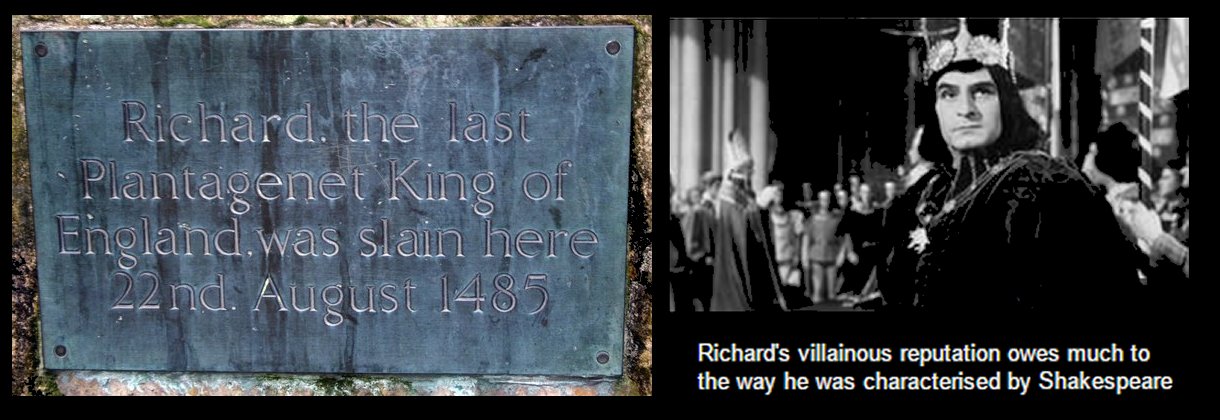 |
And Now We
Come to the End: The Fog of War
|
| |
Rick Archer's Note,
February 2017:
During
the Christmas break in 2016, I decided to devote one
week to get a general feel for the history of
England. I wrote a light-hearted story that
poked fun at the legend of Robin Hood and Richard
the Lionheart, the man I was said to be named for.
Then one
day while researching my Richard, I stumbled across
another Richard... yes, Richard III. I came
across the Smithsonian article I have reprinted
above. My hat goes off to Linda Rodriguez
McRobbie who wrote a very succinct summary of the
Richard III history, the controversy surrounding his
name, and the discovery of his bones.
The
moment I read this line... "Of
course, Shakespeare’s depiction of Richard III is
about as historically accurate as any period film
Hollywood ever produced—dramatized to a point just
past recognition"...
I was hooked. Ms. McRobbie could just as
easily been talking about Richard the Lionheart, a
fictionalized hero if there ever was one.
Could there just as easily be a fictionalized
villain named Richard as well?
My dear readers
might find this hard to believe, but I had never
heard of Richard III before. It is my
understanding that every English schoolboy and
schoolgirl find themselves immersed in the War of
Roses at some point, but my history lessons
concentrated more on the Alamo and the Battle of San
Jacinto. That is why I enjoy travel so much
because it gives me a chance to explore worlds I
never knew about before.
After
reading the Smithsonian article, my one-week
adventure turned into a two month journey through
the History of England.
And what
exactly have I learned?
One
thing I learned is the more I know, the less I know.
This was a humbling discovery to be sure. As
an example, at one point I was convinced that Lord
Stanley, the devious one, could very well have been
the one who murdered the Princes in the Tower.
I was
very curious why no one but me thought this way.
After all, I am brilliant, yes? (just
kidding). So I emailed Mr. Gareth Streeter,
one of the best writers I had come across.
On Tue, Feb 7, 2017 at 9:23 PM,
Rick Archer <rick@ssqq.com> wrote:
Mr. Streeter,
My name is Rick Archer here in Houston,
Texas, of all places. I will be visiting the
UK in June so I thought I would get a
head-start on the history.
I have been immersed in the War of the Roses
for two months. I find myself most
fixated on Lord Stanley.
I agree with you that Margaret Beaufort is
not likely to be a 'sinister child killer'.
But Lord Stanley seems just as cold-blooded
as Richard III.
I have yet to find a source that points the
finger at Lord Stanley, but I have a sneaky
feeling I am missing something. Surely
Stanley could find a henchman or pay a guard
to do the deed. However, since I am
unfamiliar with how tight the security was
in the Tower, maybe this idea is out of the
question.
Would you be willing to shed some light on
the matter? Why does Lord Stanley keep
getting overlooked? He would have much
to gain with a grateful stepson (Henry) on
the throne.
Mr.
Streeter was kind enough to reply.
From:
Royal History Geeks
Sent: Friday, February 10, 2017 6:11
AM
To: Rick Archer
Subject: Re: Did Lord Stanley murder
the Princes in the Tower?
Hi Rick,
Thanks for your email.
You're not alone in pointing the finger at
Lord Stanley. Historical fiction writers
such as Philippa Greggory have implicated
him, although as an accomplice to Margaret
Beaufort.
Have you read the Croyland Chronicle (c.
1486) and the account of Dominic Mancini
(the only contemporary account)?
Collectively these give us a fair bit of
info about how the Princes were drawn
further deeper into the tower and all but
Richard's closest and most trusted servants
were dismissed and denied access to them.
It is this that is at the heart of the
compelling - although circumstantial -
evidence that the poor lads could only have
been killed on Richard's orders or at the
very least, he would soon have found out
about it. To me, it seems strange that if
Stanley had done the deed, that Richard
would not have been able to trace it back to
him. Exposing the killer would have done
Richard a favour - he could make it clear
that the boys were dead but also that he was
blameless. Such a scenario would probably
have meant the Tudors never came to power.
I hope you enjoy your visit to the UK!
Gareth
Croyland Chronicle? Dominic
Mancini? Who are these guys?
This was
the moment I realized the more I know, the less I
know.
The game
of getting it right when it comes to History is a
lot more difficult than I realized.
Let me
share a funny story. Once upon a time, I was
watching a Houston Rockets basketball game with a
friend. During the game, a player who was
rarely used was put in at the end of the game.
He missed one shot after another and made several
mistakes. I severely criticized the athlete to my
friend. Too slow, can't shoot, can't play
defense! I was so sure of myself.
By
chance, a couple months later I found myself
guarding this man in a pickup basketball game at a
city gym. It was, as they say, a quirk of
fate. I was surprised to see the man wasn't
much taller or bigger than me. For a moment
there, I thought I could hang with this guy.
Nope.
This
gentleman went around me so fast I never even took a
step. He got to the rim and dunked the ball!!
Then he came back, slapped me on the butt and
smiled. Then he did it again. It was
almost like he 'knew' that I had disrespected
him. I would never criticize this man again
nor would I ever criticize another pro athlete for
the rest of my life. This man had taught me a
very valuable lesson... don't go shooting your mouth
off when you don't know what you are talking about.
With
that lesson in mind, I am well aware that various
comments I have made in my long saga may very well
be misinformed. I am hardly an expert, but I
do enjoy writing about history. Therefore, let
it be known my main purpose is not to convince
anyone I am right, but rather to amuse and inform.
Let me add one more thing - I have not made anything
up. I simply share what I read; you have my
word on that.
Now I
would like to discuss the Fog of War.
During the 1471 Battle of Barnet, fog... yes, fog as
in mist, murk, cloud, haze... played a huge part in
the outcome of the battle. However, more often
Fog of War represents 'confusion' during
battle.
Medieval battles were notorious for confusion
because visibility and communication were often
limited.
I
contend that there might be a third meaning for Fog
of War. During my research on the Battle of
Bosworth, I found several delightful
inconsistencies. Let me share them with you.
I think you will enjoy them.
Example One of the
Fog of War: The 'Over My Belly'
Contradiction.
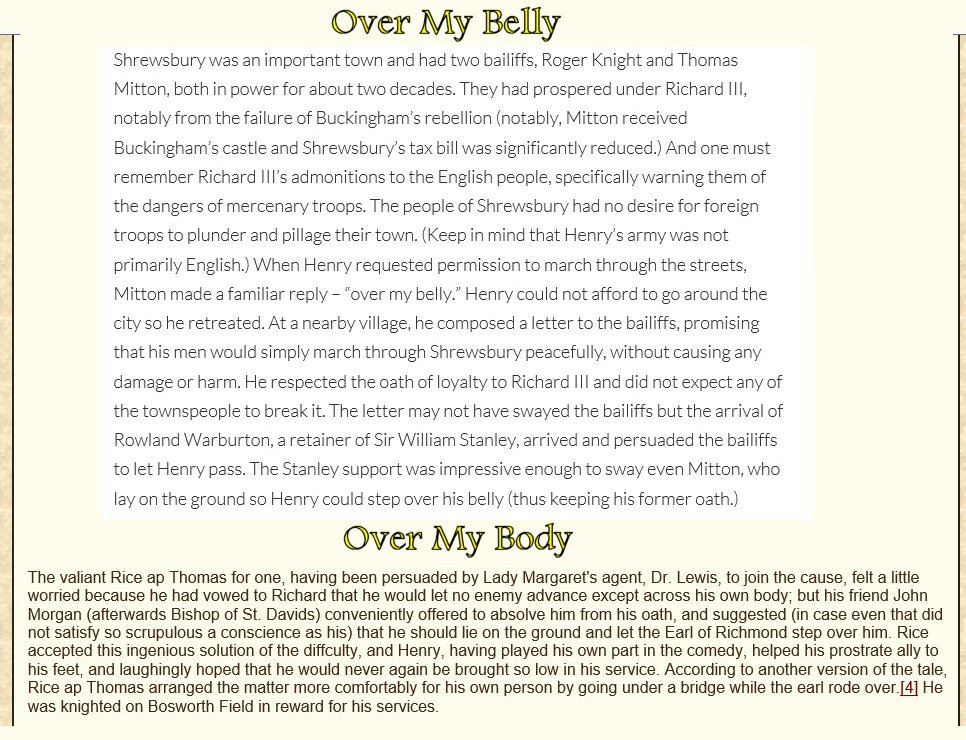
So,
which story do I believe? Which one is
correct? After flipping back and forth
between websites, I decided they very easily could
both be correct. Perhaps this was a phrase
that had common usage back in those days.
It is
pretty amazing all the phrases we have in our
language that we take for granted. And yet we
have so little understanding of where they come
from. The phrase 'Lose One's Head' has
come to mean 'not thinking straight' or 'lose
one's temper'. Obviously this phrase had a
somewhat different meaning during the War of the
Roses.
Back in
Nineties there was a well-known email that made the
rounds titled 'Life in the 1500s'. This
email explained the origin of many common phrases of
today. My favorite explanation was 'Raining
Cats and Dogs'.
We have all heard of thatch roofs, well, that's
all they were. Thick straw, piled high,
with no wood underneath. These roofs were
the only place for the little animals to get
warm. So all the pets; dogs, cats and
other small animals (mice, rats, bugs) lived in
the roof. When it rained it became
slippery so sometimes the animals would slip and
fall off the roof. Or they got so wet they
deserted the roof to find drier places.
Thus the saying, "it's raining cats and dogs."
Truth or
nonsense? Sounds plausible, but my bullshit
detector suggests someone very easily could be 'pulling
my leg'. Hmm, I wonder where that phrase
come from? If someone can answer that, I will
let them walk over my belly.
| |
The
Mysteries of the Battle of Bosworth
|
| |
Example Two of the
Fog of War: The Mysteries of the Battle of
Bosworth
My
problem with History is these darn historians keep
changing the storyline. For example, earlier I
explained how disappointed I was to learn that
Richard the Lionhearted, for whom I was named, was
one of the worst kings in English history.
That was a bit of a shock considering I had seen
movies and read books as a little boy that suggested
otherwise. I am still in therapy.
Moreover, that was not my only rude awakening.
There have been many. For example, Sam Houston
was the victor at the Battle of San Jacinto which
avenged the Alamo and gave Texas its independence
from Mexico. My hometown of Houston was named
for the guy. Sam's a big hero, right?
That is what I was taught in Eighth Grade Texas
History. So imagine my discomfort when yet
another childhood hero was knocked from his horse.
Guess
how I felt when I saw the 2004 'Alamo'
movie with Dennis Quaid portraying good old Sam as a
drunk and a coward? Rumor has it Houston spent
most of his time avoiding a fight because he was
badly out-numbered. Finally Houston's own men
had to bully him into fighting. Theoretically
the Texans won the battle because the Mexicans were
lulled to sleep by Houston's constant evasions.
Santa Ana himself was said be sound asleep when the
battle started thanks to a mulatto prostitute known
as the San Antone Rose who kept him up all night in
his tent. So kudos to Sam Houston for his
strategic evasions, but the real victory credit goes
to Ms. Rose.
About
two months into my research on the War of Roses, I
made a new friend... Ambion Hill.
Ambion Hill was my reference point for all the
stories about the military movements during
Richard's last battle at Bosworth. But I kept
getting confused by the different battle reports.
I could not figure out why the various stories
contradicted each other. Then I solved the
mystery.
Take a
look at these two maps and see if you can find any
discrepancies.
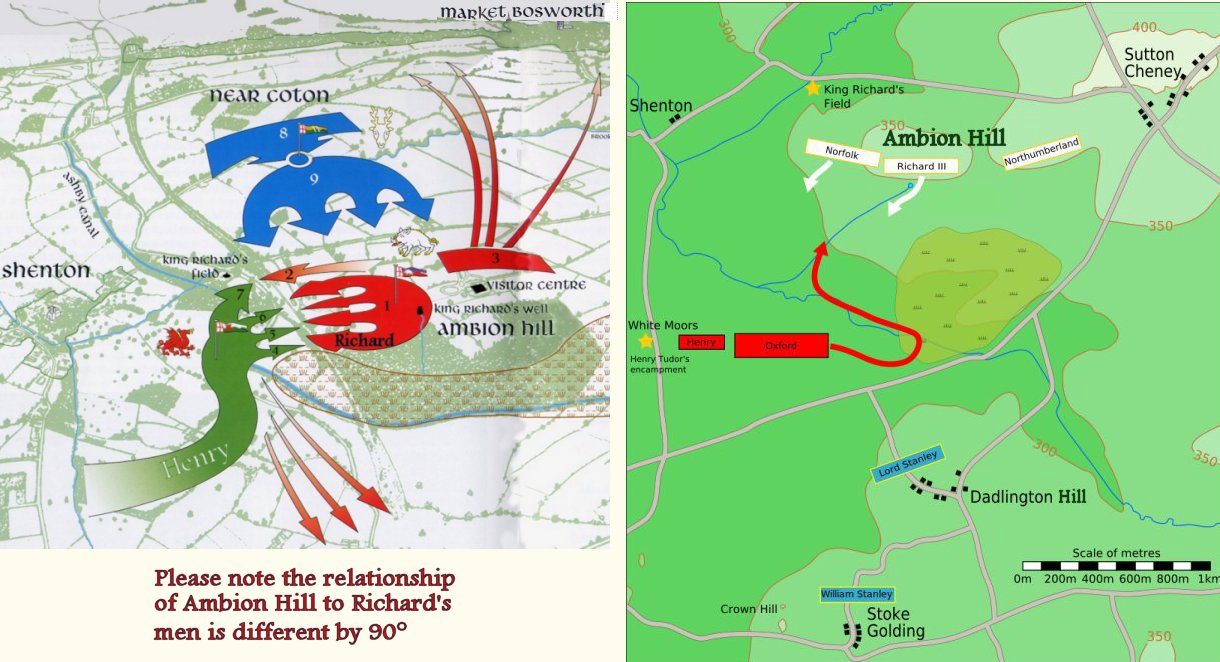
| |
|
On the surface, the two maps have much in
common. Both the White map and the
Green map show Henry's army advancing
northeast in some sort of curve from the
southwest. The Green Map places
Richard a bit more northerly, but there is
enough similarity to see the initial
skirmish had either an East-West or
Southwest by Northeast alignment. So
far, no problem. One can adjust.
However things get more curious when I add
the Color Key to the White Map. This
helps us understand what that
giant blue
blob
is up at the top
of the White Map.
Are you starting to catch on that something
is off here? The White Map has the
Stanleys in the North, the Green Map has the
Stanleys in the South.
|
 |
| |
But wait!!
I'm not finished yet!
"Debate has raged
for centuries over the exact location..."
No truer words have ever been spoken.
Here is a third map of the battle.
Ambion Hill is our one constant,
but the alignment of the four armies has
rotated yet again. Now Richard is in
the south.
One thing all three maps have in common is
that each map has William Stanley positioned
on the 50 yard line prepared to intercept
Richard's mad charge at the critical time.
So how much does this map confusion matter?
On the surface, probably not much.
Either way, Richard III is still dead.
Now I have question. Can you guess
which map is the correct one??
Obviously someone made a mistake. And
if one person can make a mistake, someone
else can make a mistake too. As it
turns out, this map confusion is masking a
much deeper problem.
Prepare to be amused!!
As it turns out, all three maps are
completely wrong. Not one of them is
even remotely correct. Not even close.
Let's find out why.
|
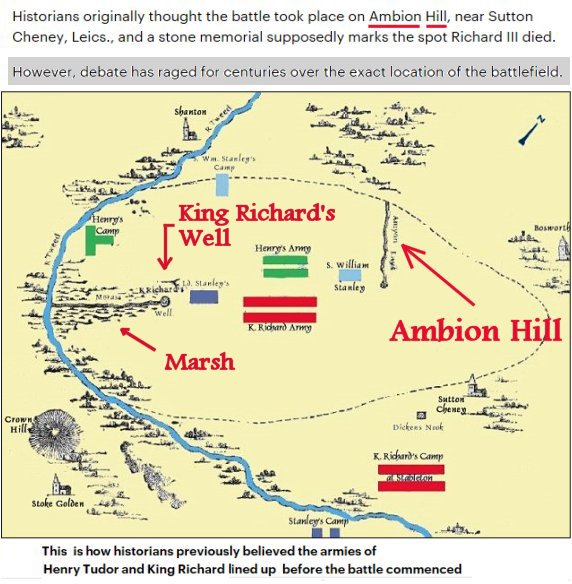 |
| |
|
Let us
begin by reading this Wikipedia description of the
Battle of Bosworth. I have highlighted the
important parts.
In their
interpretations of the vague mentions of the battle
in the old text,
historians placed areas near the
foot of Ambion Hill
as
likely
regions where the two armies clashed,
and thought up
possible scenarios of
the engagement. [98][99][100]
In their recreations of
the battle, Henry started by moving his army towards
Ambion Hill where Richard and his men stood. As
Henry's army advanced past the marsh at the
southwestern foot of the hill, Richard sent a
message to Stanley, threatening to execute his son,
Lord Strange, if Stanley did not join the attack on
Henry immediately. Stanley replied that he had other
sons. Incensed, Richard gave the order to behead
Strange but his officers temporised, saying that
battle was imminent, and it would be more convenient
to carry out the execution afterwards.[101] Henry
had also sent messengers to Stanley asking him to
declare his allegiance. The reply was evasive—the
Stanleys would "naturally" come, after Henry had
given orders to his army and arranged them for
battle. Henry had no choice but to confront
Richard's forces alone.[38]
Historical sources regarding the actual
battle at Bosworth are
scanty
at best. No
one who actually fought at the battle recorded
the battle;
typically, the chroniclers from London recorded
great events but
they were far from the action in 1485.
Also, the
supporters of Richard III did not want to remember
their defeat – and unlikely to write about in the charged political climate. Henry’s supporters were
concerned with more immediate matters after the
battle – namely, beginning the rule of a very
inexperienced monarch who had not been to England
in fifteen years.
Vague...
likely...
possible...
scanty...
No one recorded the battle...
far from the action in 1485
Do these
words inspire confidence? Not hardly.
Don't blame the well-meaning scholar who wrote this
article. He or she is basically saying:
"Sorry,
Wikipedia visitors, but I don't have a clue what
really happened. All I can do is depend on
a lot of hogwash passed down from 500 years ago
that was written by people who weren't even at
the battle site in the first place."
I think
we can safely assume there were no sportswriters in
the stands for this battle. There were no
photographs to rely on, no drawings, no post-game
interviews, no newspapers, no next-day talk shows,
no magazine follow-ups, nothing. Sure, rumors
were started, but how reliable were they? The
first serious account of the battle was not even
written until 18 years had passed!
This is
what I mean about the Fog of War... a
lot of details get lost or they get deliberately
altered. I also believe key details are made
up or embellished by someone's imagination to suit
their purposes.
(I
apologize in advance if my next comment offends
anyone, but what if the same thing is true for the
Bible? But that's another story.)
Wikipedia goes on to make the same point I do:
The multitude of different accounts, mostly
based on second- or third-hand information, has
proved an obstacle to historians as they try to
reconstruct the battle. Their common
complaint is that, except for its outcome, very
few details of the battle are found in the
chronicles. According to historian Michael
Hicks, the Battle of Bosworth is one of the
worst-recorded clashes of the Wars of the Roses.
The only
thing everyone seems to agree on is that there are
more theories than there are facts. In
his book about Richard III, Charles Ross said that "There
are almost as many different accounts of the battle
as there are historians".
What is
very interesting about the discovery of Richard's
remains over in Leicester is that someone got at
least some of the story right. The details of
the disposal of Richard's body were obviously
accurate enough to lead the archeologists straight
to Richard's grave.
That
said, although they got Richard's burial site
correct, they really blew it on another key fact.
This next one is a whopper, so make sure to have
your computer seat belt on.
| |
| |
The 500th
Anniversary of the Battle of Bosworth
|
| |
As a warm-up exercise up for our next story,
first I have a job for you.
Find Waldo!
Now I want you to identify the Word
next to Waldo.
Once you have the 'Word', try to
remember it.
Now
please proceed
further.
|
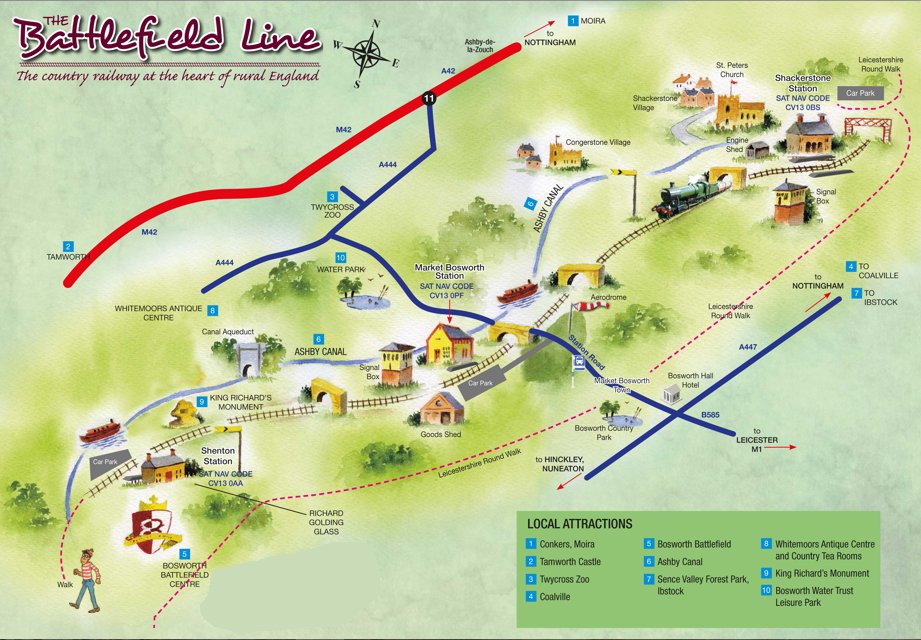 |
| |
|
Back in the Seventies, someone noticed the
500th anniversary of the 1485 Battle of
Bosworth was just around the corner.
Bosworth has been described as
“one of England’s four great decisive
battles of the last 1,000 years,” by the
UK Battlefields Trust
(Hastings, Battle of Britain, and Naseby are
the others).
The chairman of the Battlefields Trust
spoke up, "We face public spending cuts
but these places are a potentially a huge
revenue earner. Normandy alone has 10
times more battlefield centres than there
are in the whole of the UK."
The Leicestershire County Council got the
hint. They thought it would be a good
idea for tourism and commemorative purposes
to build a vacation complex dedicated to the
history of this important event. Now
solidly behind this
plan, in 1973, they purchased a large,
expensive tract of land next to Ambion Hill,
the location of the Battle.
An expert was hired to
help create a museum. He would be
responsible for descriptions of the battle
that would accompany the exhibits at the
Battlefield Visitors Center. Murals,
models, sketches, sculptures and monuments
were authorized.
Large-scale
infrastructure projects were undertaken.
New roads were built, old roads were widened
and improved. A hotel was built.
Plans were made for a special train to bring
tourists over from Leicester, the nearest
city.
A bike trail was
built. A long walkway was built that
stretched all the way to Leicester 20
kilometers away (12 miles). A water
park was built. A forest park was
built. A zoo was built. An
antique center was built. A canal was
improved for boat rides.
It was a huge, very
expensive, very ambitious project that took
about ten years in the making. But
Leicestershire got it done.
It was now 1985.
Considering the buzz surrounding this
project, people whispered this could be
bigger than Stonehenge. The
entire country was poised to visit the area
for the celebration.
Large-scale
reenactments of the battle involving
costumes, horses, weapons and hundreds of
volunteers were scheduled. A large,
open-air stage was built for plays like
Shakespeare's Henry V,
Henry VI, and of course
Richard III.
This was going to be
such a big deal!! The entire town
would greet the visitors in medieval
costume. Battles! Jousting!
Archery contests! Executions! (well,
maybe a few fake ones).
But then something
weird happened. On August 8th, two
weeks before the big event, an article
written by a man named Colin Richmond
appeared in History Today.
Richmond's article
stated unequivocally that the Battle of
Bosworth did not take place where they said
it did.
As one might gather,
the article created a giant uproar.
The Guardian covered the
story. The London Times
covered the story. The entire country
was in a tizzy debating the story.
How was it possible to
get the wrong battlefield?
Think about the
members on the Council. How do you
suppose they felt? Ten years of
effort, millions of dollars of investments
to make this area the perfect place to visit
and now on the eve of this giant event, the
whole shebang could go up in smoke.
If this Richmond
bloke was right, the Battle could just
as easily have taken place in another
county!
5 miles away? 10 miles away?
20 miles? Blimey, they might
rename the Battle! If so, this
entire Bosworth Vacation Paradise is
down the drain.
This was intolerable.
This bad news threatened to devastate
attendance at the upcoming gala celebration.
A decision was made. Someone's head
needed to go on the block.
With visions of
canceled hotel rooms, someone suggested the
best way to guarantee full attendance would
be to have a genuine execution after all.
Plus they were mad enough to do it.
How about using Colin
Richmond? Gee, what a great idea!
|
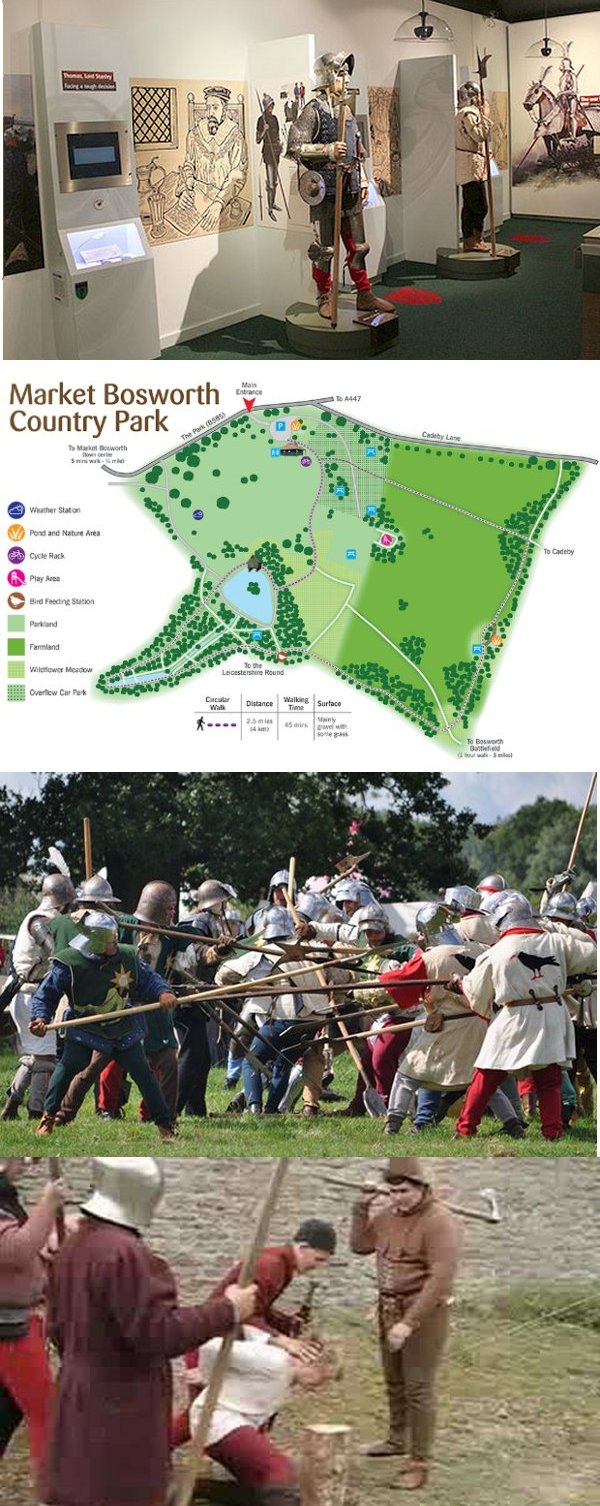 |
| |
The
Bosworth Battlefield Disappears!!
|
| |
Example Three of the
Fog of War:
The Startling Disappearance of
the Bosworth Battlefield
How absolutely embarrassing!!
Just about the time England was ready to
commemorate one of the four most important
battles in history, no one could figure out
where the damn battle actually took place.
This was all Dr. Richmond's fault. Off
with his head!
Fortunately for Dr. Richmond, at the last
minute they decided not to execute him after
all. Richmond got lucky when Princess
Diana agreed to come to the 500th
anniversary celebration. Much to the
relief of the organizers, Diana's superstar
presence guaranteed the crowds showed up
after all (incidentally, I hope everyone
knows I am teasing here).
But that did not mean this controversy was
going to be swept under the carpet.
Far from it.
Let's see if we can understand how five
centuries of English scholars managed to
misplace an entire battlefield.
Oddly enough, the town of Market Bosworth
had virtually nothing to do with the famous
battle. Instead, Ambion Hill (or 'Ambien
Hill' if you prefer) would play a
pivotal role in this mystery.
As one may have noticed, every description
of the Battle of Bosworth uses Ambion
Hill as a starting point. So
let's have a closer look at Ambion Hill.
Ambion Hill is located two miles south of
Market Bosworth. It is said to rise
all of 350 feet high. By comparison,
the massive Houston Astrodome in my home
town rises 218 feet. But don't get
excited... the land around it is about 300
feet high. In other words, the hill is
about 50 feet high.
|
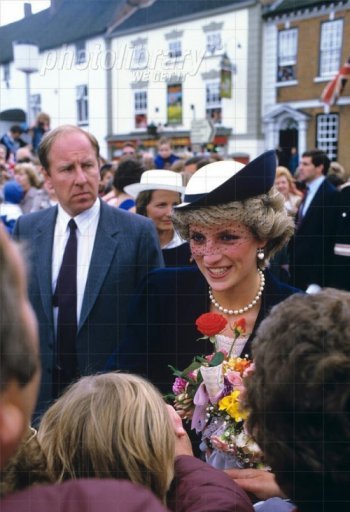 |
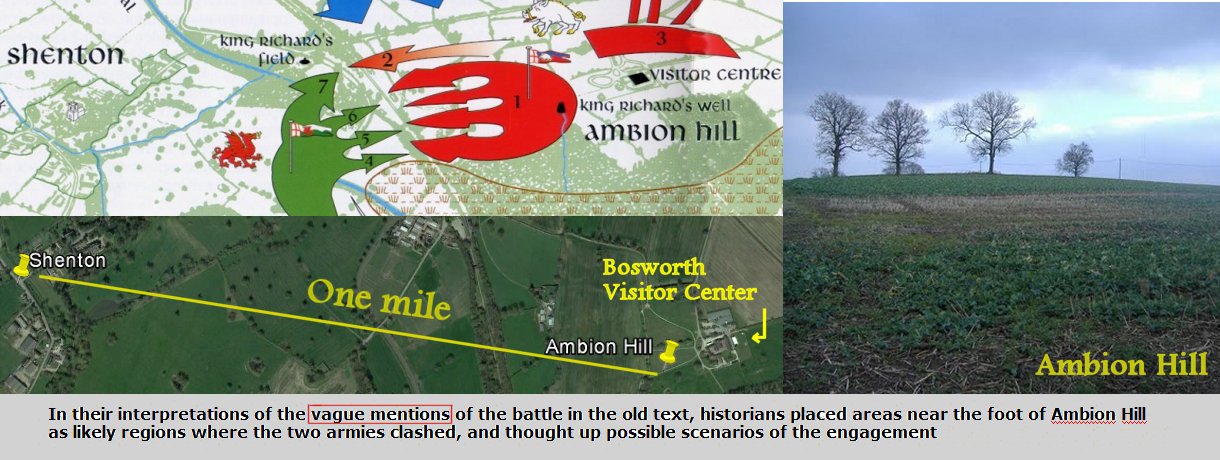
|
Notice
the phrase "VAGUE MENTIONS".
Ambion
Hill is not very high and not very remarkable.
In fact, I have a suggestion: ignore Ambion Hill.
Even
though countless battle descriptions and maps have
made a huge fuss over this hill, as it turns out,
not one drop of blood was spilled at Ambion Hill
during the Battle of Bosworth.
And why
was that?
Oh my
gosh, it turns out the battle took place somewhere
else!! How could this be??
Yes,
believe it or not, it turned out that Colin Richmond
was right. The historians had pegged the wrong
spot as the original battle site.
Ambion
Hill was a fraud, a pretender.
Poor
Ambion Hill.
Its
place in English history was illegitimate.
Join the
crowd.
|
 |
| |
|
So now I
have confirmed that the location of the battlefield
was lost. But don't get upset, this has
happened before. The best example is the
Trojan War. Many scholars assumed that both
Troy and the Trojan War were figments of Homer's
imagination to help write best-sellers, sort of like
modern day historical fiction writers who stretch
things a bit and use mythology to advance their
plots.
As it
turned out, the site of the Trojan War was located
in Western Turkey. It was by German
archeologist Henrich Schleimann in 1871 (story).
So much for all those smug, highly-educated scholars
who claimed the place didn't even exist.
As for
the Battle of Bosworth, some might say this mix-up
was even more embarrassing. They had invested
millions of dollars in the wrong spot. This
was supposed to be hallowed ground, not some
ordinary spot for some dog to do its business.
All those stone markers suddenly had lost their
meaning.
Considering the importance of Bosworth, this would
be akin to misplacing Gettysburg here in the States.
Or worse, losing the Alamo, the Texas answer to
Sparta's Thermopylae.
So what
went wrong?? Well, the Fog of War.
What else?
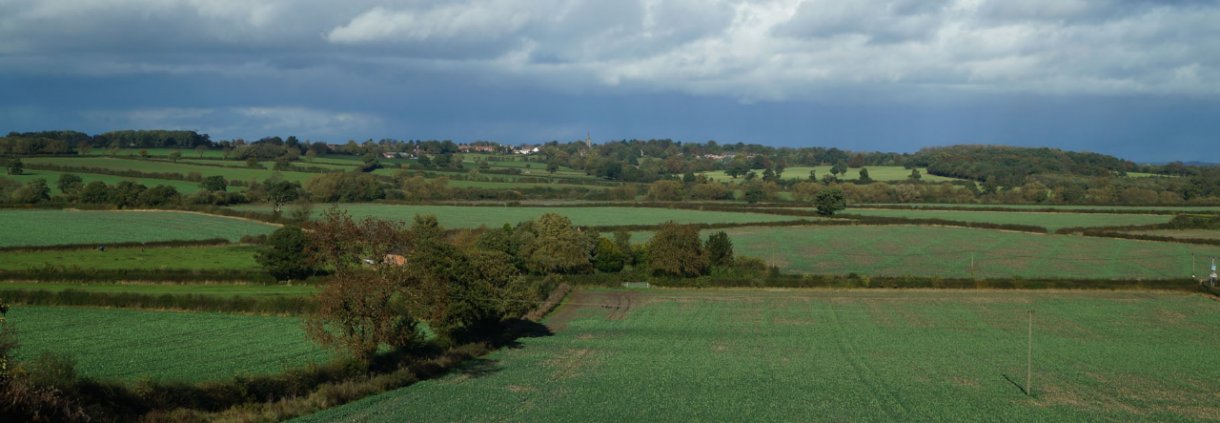
The main
culprit was the terrain. This part of England
is flat. Very flat. There are virtually
no landmarks of note. Forgive me if I am
wrong, but I think I read somewhere that there are
only two hills in the entire region. Surely I
am mistaken, but this picture of the area around
Ambion Hill suggests it could be true. The
landscape is so unremarkable it could be true.
Let's just say the absence of any distinguishing
topographical clues would help explain why the
battlefield began to disappear over time. Any
one of those fields in the picture could be the
battle site.
After
the battle, no one bothered to write anything down.
Why bother? After all, the people who lived
there knew where the battlefield was. Besides,
very few people in this rural area could read or
write. These were the medieval times when
illiteracy was rampant. Therefore, we can
assume that local reports were scarce. Five
years passed. Ten years passed. Fifteen
years passed. Three more years passed.
Finally in 1503, eighteen years after the battle, a
guy named Polydore Vergil was hired by Henry to
write the history of his reign.
Vergil
(c. 1470-1555) was an Italian humanist scholar,
historian, priest and diplomat who spent most of his
life in England. Vergil has been dubbed the "Father
of English History". The Richard III
Society has a different name for him... "Public
Enemy #1".
Just in
case my fellow Texans have not caught on yet, there
are many people over in England who love to argue
over anything to do with 'Richard the Third' or
'Henry Tudor'. They will argue over
Shakespeare's play. They will argue over just
how deformed Richard was (for the record, he
suffered from scoliosis). They will argue over
who killed the Princes in the Tower. They will
argue over where his recently discovered bones
should be re-interred.
Seriously, the animosity in England reminds me of
ancient Civil War tensions that rear their ugly head
here in America from time to time. If you ever
visit England, just be aware that any mention of
Vergil's so-called hatchet job on Richard still
raises everyone's blood pressure.
Vergil
was hired by Henry Tudor to write a favorable
account of his life. According to some, Vergil
had a clear understanding of who was writing his
paycheck. He is said to have slanted the facts
against Richard.
Indeed,
the Richard III Society really
dislikes Polydore. They are bitter because
there was no one to defend Richard's reputation, so
Vergil had a field day. The Richard III
Society not only accuses Vergil of
destroying documents that contradict any positive
point of view of Richard, the Society claims there
are numerous errors in Vergil’s account of the
reigns of Edward IV and Richard III.
To begin
with, they say Vergil is the guy who started those
mean rumors about Richard having a withered arm.
Even worse, Vergil was the first person to 'document'
the ugly rumors that Richard was responsible for the
murder of his nephews.
Vergil's
statements refer to Richard as spiteful, malicious,
fraudulent, graceless, wicked, mischievous, frantic
and mad. Virgil claimed Richard's villainy
caused his defeat at Bosworth because all his men
deserted him, forcing him to fight alone. Plus
he smelled bad (actually I made that one up).
|
| |
|
Vergil's
work gave Henry what he wanted – an account
depicting the crimes, faults and unpopularity that
defamed King Richard III for time immemorial.
With his so-called History of England,
the cards were stacked against the unfortunate
Richard III.
Indeed,
Shakespeare's Tragedy of Richard III,
the play that makes Richard a villain, is largely
based on Vergil's work.
However,
keep in mind that Vergil has his supporters too.
There are a lot of people who think Polydore Vergil
is wonderful. One doesn't get named the 'Father
of English History' without a considerable fan
club.
Personally speaking, I don't want to get in the
middle of this. All I care about is to find
out what happened to poor Ambion Hill.
Vergil
is the man credited with naming the fight the
Battle of Bosworth. Market Bosworth
is a tiny hamlet of 2,000 people located about 2
miles north of Ambion Hill.
Unfortunately Vergil never bothered to visit the
Bosworth location when he wrote his description.
That explains why his details of the physical
lay-out are few and far between.
As it
turns out, it is the 'marsh' mentioned
by Vergil and a 'hill' that set the
history detectives looking for some marsh-hill
combination south of Bosworth. Vergil didn't
give them much to go by, did he?
|
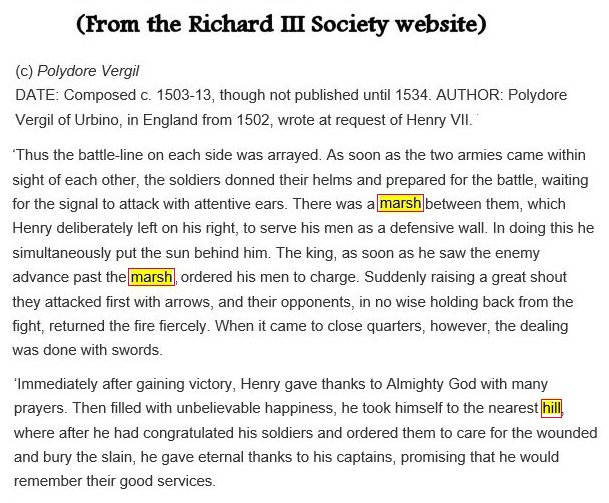 |
| |
Raphael Holinshed (1529–1580) was an English
chronicler. His work, commonly known as
Holinshed's Chronicles, became instrumental
in placing the battlefield's location.
Holinshed based his 1571 description of the Bosworth
Battle on Vergil's work. However, since
Holinshead lived only six miles from the battle
site, his writing gives hints that he may have
actually visited the site. Holinshead added
more details about both the marsh and the hill.
Holinshed
had two key phrases:
"Betweene both armies there was a great marsh
then (but at this present, by reason of diches
cast, it is growne to be firme ground."
What,
the marsh has disappeared? Uh oh. That
makes the 'hill' reference twice as
important.
"King Richard pitched his field on a hill
called Anne Beame, refreshed his soldiers and
took his rest."
Note
that if we break the word 'Beame' into two
syllables, we get 'Anne Be Ame', then say it
fast, it sounds like 'Ambion'.
|
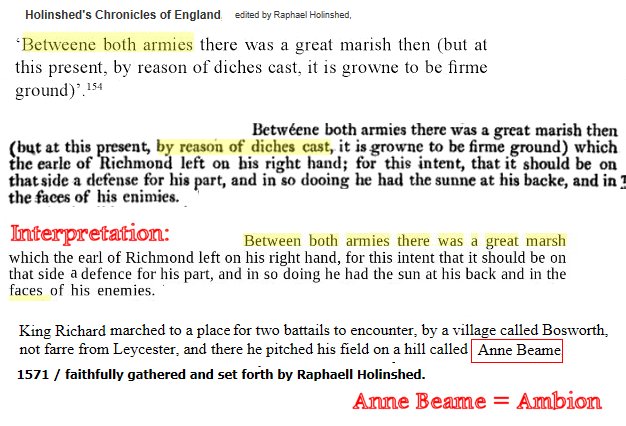 |
| |
|
Holinshead can therefore be credited with bringing
Ambion Hill into the picture. So what if there
was no marsh? After all, Holinshead said it
dried up. Voila! That would explain why
there was no marsh around Ambion Hill to any
Johnny-come-latelies.
This is
a modern picture of the town of Market Bosworth.
As one can see, the terrain south of the town is
remarkably flat.
In 1785,
an amateur historian named John Robinson became the
first to state that 'The Ambien' was 'the
supposed place of the engagement'.
Since
Ambion Hill was the main hill south of Market
Bosworth, no one objected too strenuously. As
if someone actually cared?
After
all, the Holinshead Chronicle had specifically
stated Richard camped on Ambion Hill. The
first big bump south of the town sounded like as
good a spot as any. Sure, why not?
William
Hutton (1723-1815) owned a profitable Birmingham
paper warehouse. His great fortune allowed him
time to write historical treatises AND get them
published widely.
Hutton’s
famous book "The Battle of Bosworth"
was published in 1788. Hutton was the man who
drew this map. Notice that Ambion Hill figures
prominently in the battlefield.
There
are those who suggest Hutton took these words too
seriously:
"King Richard pitched his field on a hill
called Anne Beame, refreshed his soldiers and
took his rest."
Hutton
may have been guilty of poor logic. Just
because Richard camped there did not
mean he also fought there.
Although
this book was widely criticized at the time, over
time Hutton’s work became the account upon which
most theories were based. For example, Hutton
claimed he placed the position of the famous marsh
on the northwest slope of Ambion Hill because he had
once personally trodden in it. Hutton placed
the marsh near the spring known as "King
Richard’s Well".
A return
visit in the following years failed to find any
trace of the marsh. Nevertheless, Hutton
continued to insist that what he had previously
found was "that marsh".
According to modern writer Paul Trevor Hale, Hutton
appears not to have known that the marshland in the
area had been reclaimed during the enclosure of
Dadlington and Stoke Golding in the 1580s.
Here is
the key point: Since no one really cared
enough to write a book of their own in protest, as
time passed, Hutton's book grew in importance as an
authoritative work. It became influential in
causing the hill to be accepted as the site of the
battle.
In the
absence of an alternative site, over time people
took it for granted that Ambion Hill was 'The
Place where Richard III died'.
|
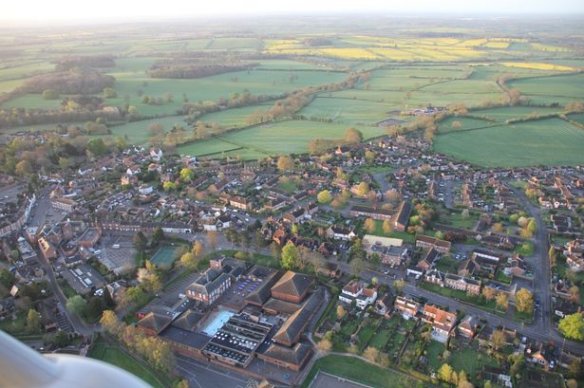
 |
| |
|
Rick Archer's Note: A gentleman by
the name of Paul Trevor Vale has written a detailed
account of how the Battlefield became the focus of
great controversy here in modern times. The
following information is excerpted from his
excellent article. I highly recommend that
anyone interested in this story read Mr. Vale's
complete account.
The
Continuing Battle of Bosworth Field
Written by Paul Trevor Vale
Original Story
In 1973, the
Leicestershire County Council purchased the
piece of land known as Ambien Farm, located on
and around Ambien Hill, near the village of
Sutton Cheney. The Council began to develop a
Bosworth Field Battlefield Centre. The Council
hired a historian to work out the battle
positions and tactics of the various
participants. Heraldic standards were
being made to mark the positions of the armies
on the morning of that fateful day: August 22,
1485.
Regarding the Differing Views of Dr. Daniel
Williams and Dr. Colin Richmond
Shortly after the project was underway, the
original historian withdrew, for reasons never
stated. He was
replaced by Dr. Daniel
Williams, lecturer in history at Leicester
University. Walkways were laid out around Ambien
Hill; the old farmhouse was converted into an
exhibition hall, book shop and snack bar; and a
car park was provided. Dr. Williams published a
24-page booklet giving his analysis. The Council
set out the flags and maps to match Dr.
Williams’ theories, and opened the Battlefield
Centre to the public.
Since 1973, many have expressed doubts about the
validity of the site. To mark the 500th
anniversary of the battle, Dr. Colin Richmond
published an article in the August 1985 edition
of History Today.
Dr. Richmond
claimed that Dr. Williams was wrong, and that
the battle was actually fought elsewhere.
Dr. Richmond’s
account was controversial enough to make the
front pages of both The Times and the Guardian
newspapers on July 27, 1985. What had previously
been private academic discussions became heated
public debate.
Richmond’s argument was that the battle was not
fought to the west of Ambien Hill, and that
William Stanley did not intervene decisively
from a position to the north. Williams placed
both Stanleys to the north, illogical from any
aspect. Richmond held the exact opposite: that
William Stanley came up from a southwesterly
direction to swing the day in Henry’s favour;
and that the main battle took place on the plain
to the south of Ambien Hill, between the Hill
and the village of Dadlington. He also advanced
the theory that Northumberland, one of Richard
III’s chief commanders, was a traitor. Richmond
seemed to think this would come as no surprise
to students of the battle. However, the revised
positioning of the battle site may prove
Richmond’s work to be a statement that tradition
does Northumberland an injustice. Unfortunately,
Richmond apparently tried to be controversial.
He made comments such as: "The manner of
[Richard’s] death may account for the sympathy
he otherwise unaccountably evokes" [emphasis
added]. This naturally angered pro-Ricardian
scholars; many of them attacked the article as a
whole, thereby discarding some interesting and
salient points.
Naturally, Dr.
Williams led the attack by defending his own
position. He wrote to The London Times
that "Dr. Richmond makes it clear that he
does not like the Battlefield Centre, but his
comment and observations seem to be carrying
pique a little too far."
In closing, Dr. Williams
stated that "There is a good deal more to be
said, but what is here supports my feeling that
the Silly Season has started somewhat early."
What makes Dr. Williams think he is right? Some
of his theories are dubious, to say the least.
Quoting the Croyland Chronicle, which states
that King Richard’s army ‘was encamped at the
Abbey of Mirival at a distance of about 8 miles
from that town (Leicester),’ Dr. Williams
concludes that, "Allowing for approximations
this would place Richard’s Camp at about 9 miles
from Leicester and about 5 miles from Merevale
Abbey, which is at almost exactly the position
of Ambien Hill". These estimated figures are
highly convenient if one’s goal is to place the
site on Ambien Hill. However, at a lecture given
on August 31, 1985, Williams stated that Ambien
is 6 miles from Merevale and 10 miles from
Leicester. Regarding the campsite of Henry
Tudor, self styled Earl of Richmond, Williams
said: "Henry and his Army arrived at the final
resting place before the Battle, their camp at
Whitemoores. The camp itself…must have been…to
the west of the intersection of Watling Street
and the road to Shenton". According to his
notes, the source for this assumption is a
"local but ancient tradition". Is this the same
tradition which had the inhabitants of Stoke
Golding watching the battle from their church
tower, that Williams dismissed in The Times
article? With Dr. Williams, it would seem that
even before dawn on the day of the battle,
August 22, 1485, we are back in the realm of
"common faith hath it..."!
It is worthwhile reiterating why Dr. Williams
wrote his account, and asking some questions.
Williams was hired to write about a battle that
took place on and around Ambien Hill: the land
now owned by the Leicester County Council.
Did the original historian withdraw
because he could not make the evidence and facts
fit this site?
Does Dr. Williams defend his theories so
often, and so vehemently, because of the vested
interest now involved in the site?
The August 11, 1985 Sunday Telegraph
called it "The Big Business of Bosworth".
Defending Colin
Richmond’s views, the Reverend Anthony Bardesley,
Vicar of Stoke Golding and Dadlington, stated
that the farmers of Dadlington were the first to
be approached by the Council with a view to
buying their land for a battlefield centre, but
they had refused to sell. Odd behaviour for a
council that "knew" the battle took place across
the valley on Ambien Hill.
(Rick
Archer's Note: I have enclosed only
one-third of Mr. Vale's original article. He
goes on to make many more valid points why the
location of Ambion Hill was absurd. Again, I
encourage the readers to visit his
web page.
For our
purposes, Mr. Vale has explained how the modern
battle lines formed. It seems that for
the purposes of tourism and heritage, with the 500th
anniversary looming, the time had come to
commemorate the famous battle. Apparently due to the
Fog of War, the idea that Ambion Hill was the
location of the battle had more or less become
accepted as fact.
So the
Leicestershire Council bought an expensive tract of
land around Ambion Hill and set about building a
Visitor's Center complete with stories and drawings
of the battle. They hired Dr. Daniel Williams
from the University of Leicester to document the
battle for their exhibits. Somewhere along the
way, Dr. Williams also became curator of the museum.
Dr.
Williams passed away in 1998. Now I have no
idea what sort of man Dr. Williams was, but even if
he was as grouchy as he was portrayed to be, I still
feel sorry for him. His obituary says he was a
popular professor at the University of Leicester.
His passion was research on the later Middle Ages.
Clearly the proximity of Leicester to the area where
the famous battle was fought help spur his
commitment to the history of the locality, and
especially its associations with Richard III.
Dr. Williams was the historical adviser who worked
with Leicestershire County Council's team to locate
and develop as a tourist attraction the site of the
Battle of Bosworth. His account of the battle site
has been reprinted many times since its publication
in 1973. A new, fuller edition was published in
1996, with a characteristically lively text and
illustrations drawn from contemporary and later
sources.
However,
Williams' obituary made no mention of what had to be
bitter heartache for the man to have his work
constantly questioned. No doubt much of his
identity and reputation was wrapped up in the
validity of his work. It must have hurt him
deeply to discover the same people who had hired him
in the first place - the Leicestershire Council -
had begun making discrete inquiries about buying
land further to the south near Dadlington... "Odd
behaviour for a council that 'knew'
the battle took place across the valley on Ambien
Hill."
|
| |
Re-Discovery
of the Battle Site
|
As we
learned from Paul Vale, Leicestershire County
Council set up the battlefield visitor centre at
what was Ambion Hill Farm, in 1974. The
Council depended on the work of Leicester University
historian Daniel Williams to establish the location
and to interpret the battle for its murals inside
the Visitor Center.
This is
a photograph from the Bosworth Visitor Center.
It appears to be a large scale model of the
battlefield. Notice the men charging
downwards... no doubt charging down from Ambion
Hill!! Very ironic.
After
the Council had gone to considerable cost and
trouble to establish this state of the art tourist
destination, the critics had a field day.
Indeed, throughout the Seventies, local
historians challenged the Ambion Hill location for
the battle, but to no avail.
Then
came 1985. On the eve of the 500th
anniversary, historian Colin Richmond dropped his
bombshell. He had uncovered a document which
said the battle had taken place at Dadlington Field.
Richmond’s article threw a real damper over the
celebrations. Talk about a party pooper!! For
the first time in 500 years, people began to notice
that Dadlington possessed the only other hill
besides Ambion in the entire county. Uh oh.
|
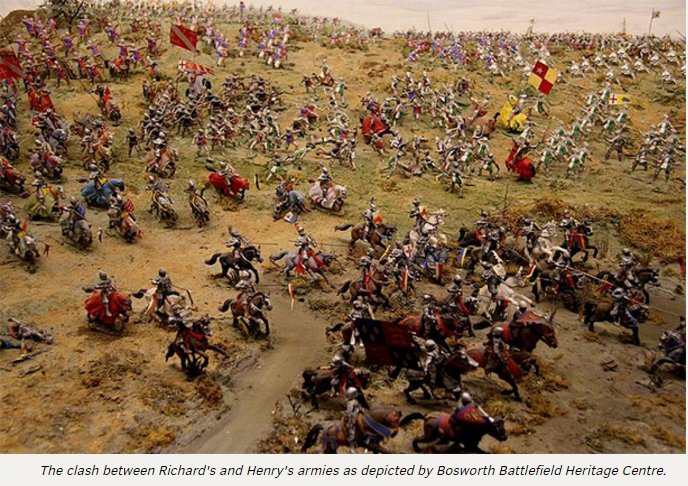 |
| |
|
The
supporters of the traditional site at Ambion Hill
would not go down without a fight. Two months
later after Colin Richmond's 1985 article appeared,
Daniel Williams, curator of the battlefield center,
dismissed Richmond’s claims vehemently.
For one
thing, where was the marsh?? Dadlington was
dry as a bone. If the glove don't fit, you
gotta acquit. If the marsh ain't there, won't
be no Renaissance Faire.
However,
now that the cat was out of the bag, people were
very worried that Colin Richmond was right.
Indeed, as debate grew heated, Ambion Hill was being
compared to Stoke Golding's Crown Hill. Was it
possible they had the wrong hill all along?
One
thing that bothered people was the conspicuous
absence of artifacts at the base of Ambion Hill.
Why can't we find an arrowhead, a spear tip or a
cannon ball or two??
Of
course there weren't any artifacts at Crown Hill
either, but they did have bones. It seems
there was a burial site for victims of the Bosworth
Battle next to Crown Hill.
This
fact was very upsetting. As we know, typically
bodies are buried next to the battle site. For
example, there are 10,000 graves located 300 yards
from Omaha Beach, site of the bloodiest D-Day
battle. If everyone died at Ambion Hill, then
why cart the bodies two miles away to Crown Hill?
Wouldn't it be easier just to bury them in soft soil
of the alleged marsh that was said to exist next to
Ambion Hill?
Five
years after Colin Richmond had opened the debate, in
1990, Peter Foss published a book that presented
powerful arguments in favor of the Dadlington area.
People were particularly impressed with his maps.
Mr. Foss had drawn several superior maps of the
battlefield to support his new theories of the
location. His book was so persuasive that
public opinion now swung heavily in favor of
Dadlington.
|
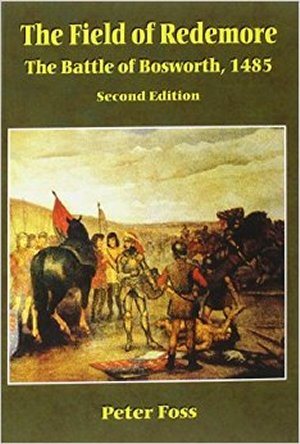 |
| |
|
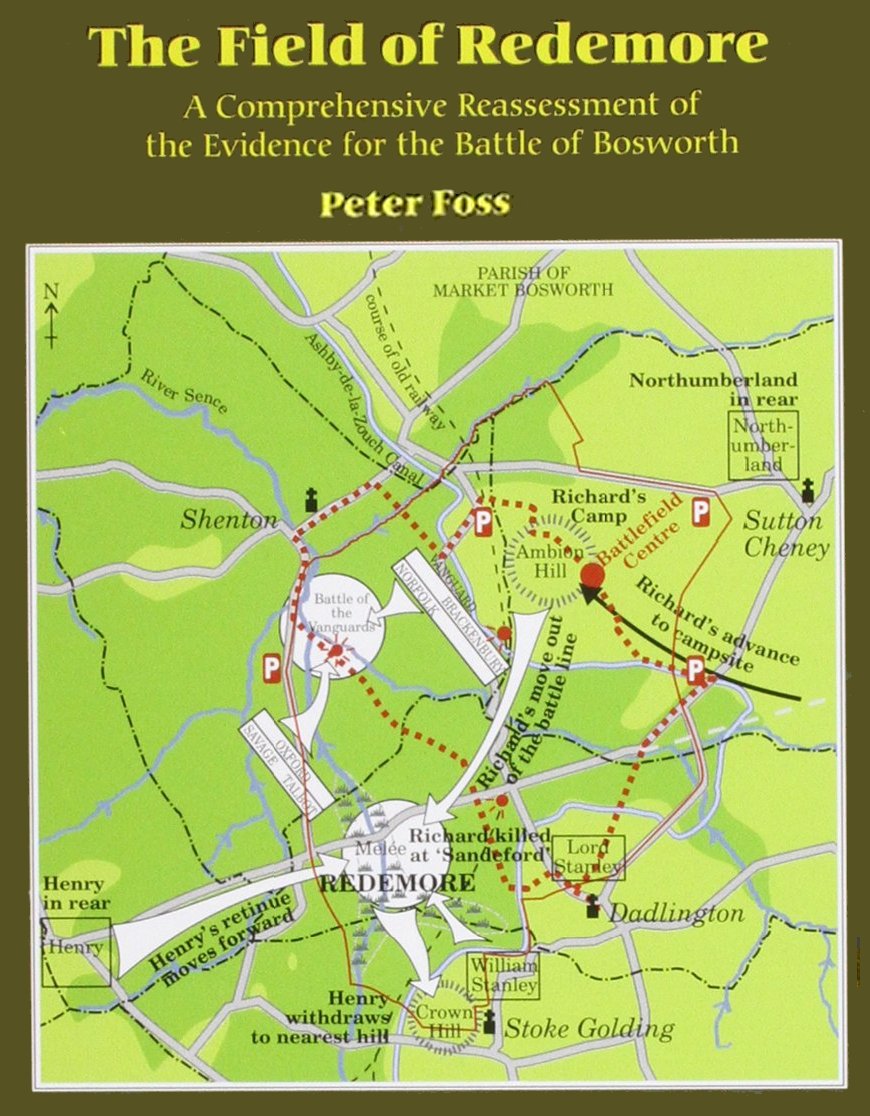 |
| |
|
According to
Peter Foss, the Ambion
Hill theory was a piece of 18th-century nonsense
proposed by a Birmingham paper manufacturer and
amateur antiquary, William Hutton.
“He was no good as an
antiquary, a dilettante really,”
said Foss.
But Hutton was widely
believed, even though his idea contradicted both
near-contemporary accounts and simple logic.
After all, it hardly seems likely that Henry
would have gained the crown by charging uphill.
Nevertheless, the people in
charge of constructing the Bosworth memorial seeming
bought his story as well.
|
| |
|
Foss
discovered in local records that ‘Redmor’
lay ‘in the fields of Dadlington’, a key factor
that reinforced Richmond’s argument.
Peter
Foss was not satisfied with discrediting Ambion
Hill, but was determined to locate the exact site.
Foss combined his expert knowledge of local
topography, geology plus a close reading of the
original sources to write The Field of
Redemore.
This
book, first published in 1990, was very influential
in swinging the tide in favor of several farms in
the vicinity of Dadlington as the more likely
location of the battle. Even though the exact
spot had yet to be pinpointed, in 1995 the English
Heritage was convinced enough to include the fields
around Dadlington in its Register of Historic
Battlefields.
Unfortunately, there were still some die-hards on
the Council who refused to accept the theory.
Their continuing stubborn attitude resulted in many
heated debates. Consequently, over
the
next decade, pressure mounted to begin a full-scale
investigation.
Finally
the Council threw in the towel. They
commissioned an expensive,
large scale
project to find the true location of the
battlefield. In 2004, a landscape archeologist
named Glenn Foard was hired to solve the mystery.
|
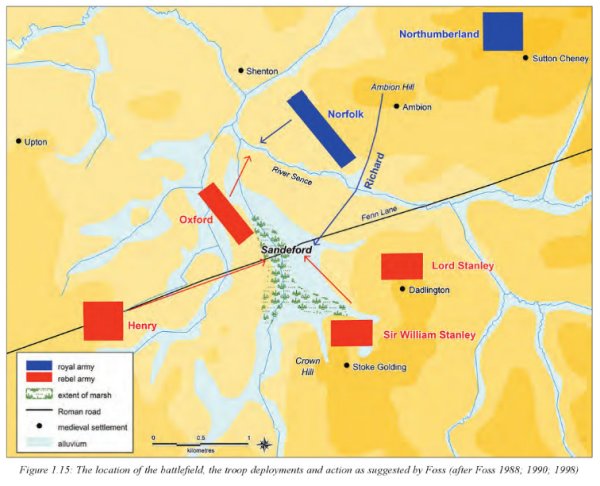 |
| |
The Battlefield Trust Project
|
Silver badge and lead
shot pinpoint site of Battle of Bosworth
Written by
Maev Kennedy
The Guardian
Friday, 19 February 2010
A thumbnail-sized silver
gilt boar, still snarling ferociously after 500
years, and a little heap of battered lead balls have
pinpointed the much disputed site of the Battle of
Bosworth, and even the spot where Richard III was
cut down by Tudor swords, becoming the last English
king to die in battle.
Archaeologists made the
announcement today close to the site where Henry
Tudor was crowned Henry VII with the crown that had
tumbled from the dying Richard's head. The
archaeologists believe the boar badge, his personal
emblem, was worn by someone who died at his side.
The crucial evidence,
including badges of supporters of both kings, sword
mounts, coins, and 28 lumps of roundshot, turned up
in fields straddling Fen Lane in the Leicestershire
parish of Upton. No historian had previously
investigated the location, which is nearly two miles
south-west of what had traditionally been regarded
as the centre of the battle.
"It took us five years to locate it, but there it
is, the Battle of Bosworth," said Glenn Foard, an
expert on battlefield archaeology, who led the hunt.
A major
find was the silver boar
badge, the emblem of King Richard III.
It was found on the edge of a field called
Fen Hole.
Dr.
Foard: "The most important
find by far is the
silver-gilt boar, which was Richard III’s own badge,
given in large numbers to his supporters.
But this
one is special, because it is silver-gilt. It was
almost certainly worn by a knight in King Richard’s
own retinue who rode with the King to his death in
his last desperate cavalry charge. It was found
right next to the site of Fen
Hole - a small medieval marsh -
and the King was killed when his horse became stuck
in a mire."
In medieval times,
Fen Hole was a marsh that played a crucial role in
the battle by protecting the flank of Henry Tudor's
much smaller army. Finding
this marsh proved pivotal in discovering the actual
location of the battlefield.
Farmer Alf Oliver was
astonished at the revelation, outside all the
parishes which have vied for centuries to claim the
honour, in his fields straddling Fenn Lane.
The lane was once a Roman road linking Leicester and
Atherstone, the towns from which Richard and Henry
approached the battle.
One of the crucial finds,
the largest of the roundshot nicknamed
'the holy grapefruit' by the archaeologists, was found just
behind one of Oliver's barns. The
shot not only maps the arc of the battle, it proves
that artillery was used by both sides in greater
numbers than previously thought.
Frank Baldwin, chairman of the
Battlefields Trust charity,
was beyond elated to see the
project come to fruition.
"The discovery
of the actual site of the battle
is just as important
to us as Heinrich
Schliemann discovering Troy."
|
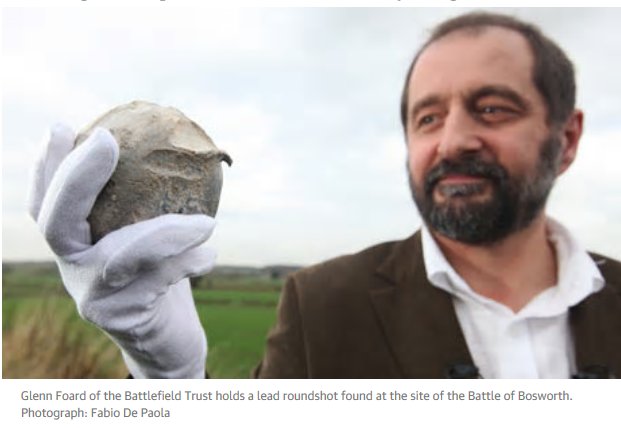
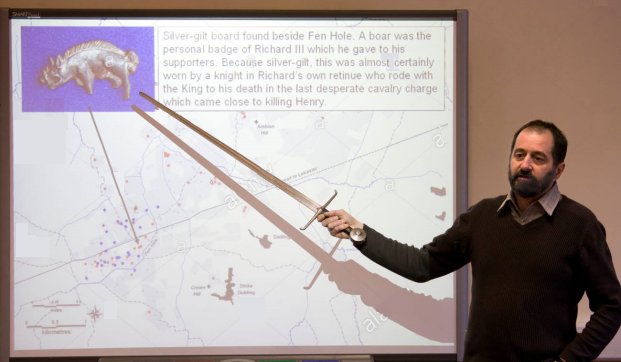
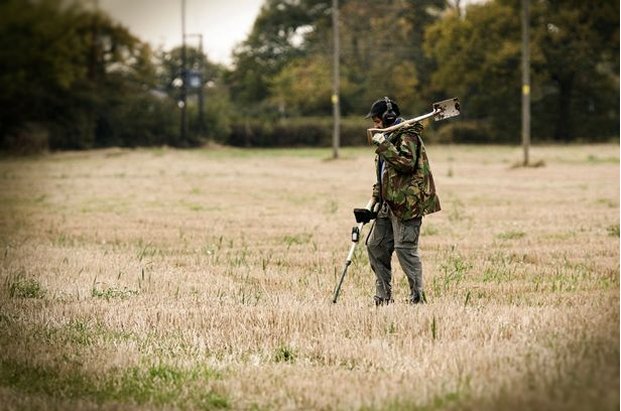 |
Give
credit to Colin Richmond for rocking the boat back
in 1985. Without
Richmond’s
earth-shattering History Today
article, it seems unlikely that this battlefield
would have never been found. Even then, it had
taken 25 more years to finally solve the mystery.
Give
further credit to Peter Foss, who participated in
the painstaking work with keen interest. It
was his
genius that had created the attitude shift necessary
to lead to this survey.
“I
never doubted my original theory about where the
correct site is. I have a great knowledge
of the area and it all made sense.
When I carried out my research they had none of
the technology they have today but my work was
very, very sound and I am delighted if it is now
recognized as being right.”
In 2004
that the Heritage Lottery Fund, the
Battlefields
Trust and Leicester County Council together secured
funding for an archaeological project led by
Glenn Foard to locate the battlefield site.
The
survey proved to be very expensive. At a cost
of 1.3 million pounds (1.6 million dollars), metal
detectors were employed, topographical surveys were
made and sophisticated soil analysis was conducted.
Even
then, it took four years to get results. No
doubt the slow progress caused much hand-wringing
and worry.
Starting
in 2005, teams of men armed with metal detectors
fanned out systematically across
farm fields. Part of the problem was that the
battlefield turned out to be further west than
originally predicted by Peter Ross.
The
initial breakthrough came on March
1st, 2009. That is when a small lead ball, 30mm in diameter, was
discovered further west of Dadlington. Once
the first ball was found, it unlocked a treasure
trove nearby.
By December
2010, 33 lead projectiles had been uncovered, a
greater number than from all other archaeological
surveys on battlefields of the 15th century
combined. What an amazing find this had been.
|
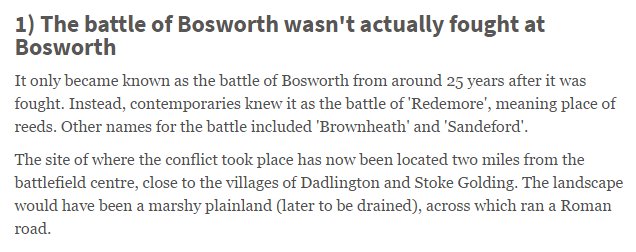
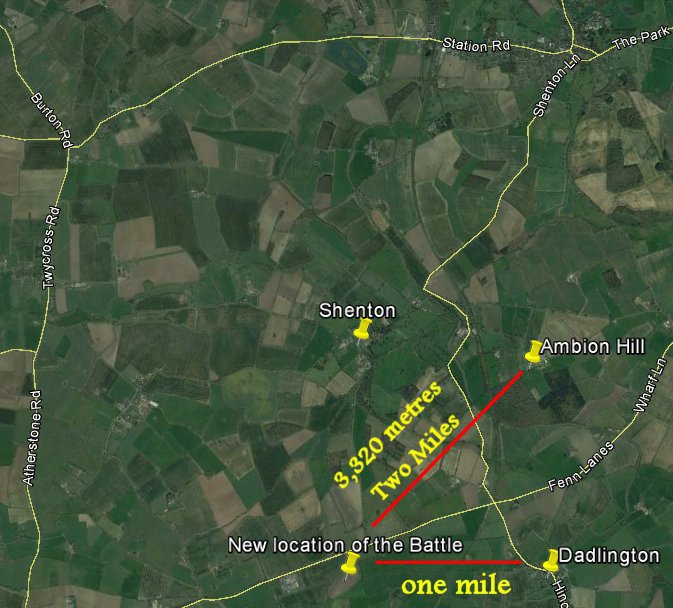 |
| |
 |
| |
Dr. Glenn
Foard's Story of the Search
|
| |
|
The
discovery took a lot longer than Dr. Foard could
have ever imagined. It had taken four long,
frustrating years to locate the correct spot.
Part of the problem was that winter and rainy season
limited the search to little over half of each year.
Dr.
Foard understood that without the convincing work of
Peter Foss, this survey would never have been
undertaken in the first place. As one writer
had put it, "The decision to hire Glenn Foard to
conduct the search
appears to vindicate the
theories of local historian Peter Foss, who has been
arguing the case since the 1980s – although not
everyone in this rather bitchy subculture wishes to
admit it."
Mr. Foss
had every right to be pleased. The decision to
finally undertake a scientific survey of the area -
an extremely costly undertaking - indicated that
public opinion had swung heavily in favor. He
believed that the Dadlington area, not Ambion Hill,
was where the battle took place. Now all they
had to do was find the darn thing.
Unfortunately, in a perverse twist, Mr. Foss had
done his work too well. Unbeknownst to him (or
anyone else), his prediction was off by about a
mile. Around Dadlington, there was one spot
after another with ancient names such as 'Redemore'
(place of the reeds) and 'Fennagh'
that hinted the marsh - long since dried up - might
have been located nearby. These marsh-related
names practically begged the researchers to have a
look.
The team
led by Dr. Glenn Foard was understandably drawn to
these fields around Dadlington, but they were to be
disappointed time and time again.
This
search turned out to be a major community effort.
On a sunny day, there might be several teams of
volunteers - college students, retirees, civic
clubs, church groups - scouring giant fields
centimeter by centimeter for hours on end.
However, they never found anything!!
Frustrated, sometimes another team did the same
area. These Google Earth images barely begin
to convey the vast amount of territory the search
teams had to cover inch by inch. This
was a needle in a haystack job.
In his
book, A Battlefield Rediscovered, Dr.
Foard explained the Foss hypothesis was
all-powerful. Assuming that the dried-up marsh
areas near Dadlington were certain to offer the
answer, the ground was turned upside down, but to no
avail.
Stage One
"Throughout the investigation of the case
presented by Peter Foss, the idea that the
battle had been fought in Dadlington township
appeared so strong that it distorted
perceptions, particularly of the data for the
distribution of wetland.
As a result, our search for peat deposits and
battlefield archeology had been extended widely
across Dadlington, even to the eastern side of
the town, which lay far away from the
concentration of places that had 'fen names'.
When we found Fen Meadow closer to
Dadlington, we really thought we'd nailed it.
However soil surveys showed that the marsh had
dried up in Roman times. We were heartsick
at the time.
Stage
Two
Yet, as we cast the net ever wider, new
options began to appear. The discovery of
the peat deposit at Fen Hole in 2007
lifted our hopes and shifted attention westward.
The evidence for wetland, heath, and moor was
reviewed and the possibility that the
battlefield lay beyond the western edge of
Dadlington was considered."
Glenn Foard
For a
variety of reasons, the westward search stopped at
the eastern side of Lychgate Fish Farm, a lake in
the lowlands. That had been their agreed-upon
cut-off point for the moment. Little did they
know that the battlefield site lay just beyond!
Frustrated that the wider search net had not panned
out, Foard's team returned to the Foss hypothesis.
They decided to ask for a second opinion on the
Fen Meadow possibility. Still, an
important idea had been sown in the back of Dr.
Foard's mind. It might still be Fen Hole...
the back side was unexplored.
In the summer of 2008, I stood on Crown Hill
with my colleague Richard Holmes. We had
spent the day touring the various locations that
had already been investigated.
Looking across the low-lying ground to the north
and west which had provided the focus for our
tour today, Richard asked a simple but
perceptive question.
"Glenn, if you forget all the caveats, what is
your gut feeling as to where the battlefield
lies?"
My mind flashed directly to an earlier thought.
It must lie west of Fen Hole somewhere
near the Roman Road.
Stage Three
Winter came and we had to stop. In the
following year, 2009, we received confirmation
that the wetland in Fen Meadow had been
gone long before the 15th century. It had
likely been drained by Roman ditches long before
the battle took place. Dead end!!
After three years of extensive work testing the
Foss hypothesis, the lack of convincing battle
archeology forced us to finally reject the Foss
interpretation.
This allowed Fen Hole to supplant Fen
Meadow as the likely candidate for 'The Marsh'.
So we moved further west.
That is when we hit pay dirt in 2009.
Glenn Foard
The
discovery, when it eventually came, was a bit
surreal because the successful team was surrounded
by other search parties studying four wrong
locations. This odd sight was further
testimony to the painful needle in a haystack
approach necessary to locate the wandering
battlefield.
The new
battle site belonged to farmer Alf Oliver
at Fenn Lane Farm. Mr. Oliver had never
imagined his farm was 'The One'. All
the best guesses lay well
beyond his farm. So when the researchers came
calling, he had assumed they were wasting their
time. Mr. Oliver admitted he was
astonished at the artifact
discoveries in his fields straddling Fen Lane.
After
four years of rotten luck, Dr. Foard said it was
about time they got lucky. They barely missed
adding another year!
“For more than a year we had hints we were close
to the action but it was only in the last week
of planned field work, in the last possible
area, that the critical evidence was found.”
As
improbable as this long search had been, there was a
silver lining - the battlefield was perfectly
preserved. Due to the hidden location, no
looting had ever taken place. Now the
archaeologists had a field day (small joke)
exploring what had to feel to them like a veritable
gold mine.
The
items discovered so far include artillery shot,
handgun shot and fragments of swords, bridle
fittings, spurs... plus three coins almost certainly
lost by combatants during the battle.
As we
know, it was the silver boar of Richard III that
provided the definitive clue that this farm was the
correct location. The boar was very small,
no bigger than a
thumbnail. It was muddy and
battered, but still
snarling in rage after 500 years.
The tiny
1.5-inch boar was found by Carl Dawson, a retired
university lecturer and one of the many volunteers
who helped scan hundreds of miles in the area with
metal detectors.
Dawson
had found the boar
on the edge of a field called Fen Hole.
In other words, Carl Dawson
had not just found an invaluable artifact, he had
discovered the all-important marsh which in
medieval times played a crucial role in the battle,
protecting the flank of Henry Tudor's much smaller
army.
Although
this
marsh was drained centuries ago,
Alf Oliver said it still gets boggy
in that spot during the
very wet summers.
One can
imagine that somewhere in that ABCDEF complex is the
spot where King Richard met his death.
Another
one of the crucial finds, a large cannonball
nicknamed 'the holy grapefruit', was found
behind one of Oliver’s barns.
It turns out that the road to Alf Oliver's farms has
an interesting name. It is known as 'Fenn
Lane'.
This road
goes way back to antiquity. Fenn
Lane was
the Roman road linking
Leicester and Atherstone.
Leicester and Atherstone
were the towns from which Richard and Henry
approached the eventual
battle site.
The only
roads back in those days were Roman roads... and
there weren't very many of them. Considering
all the various marshes providing major obstacles to
wagons and artillery, the armies would not cross the
fields for fear of 'bogging down' into the
muddy areas. Therefore common sense dictates
that both armies came straight down this road for
the big bash.
In other
words, there was considerable irony in the discovery
that this farm straddled the Roman road. Why
didn't anyone think of researching this long road
first?
Furthermore, if researchers were looking for a 'Marsh',
wouldn't logic suggest starting with sites along a
road named 'Marsh Road'? Unfortunately,
there were no roads named 'Marsh Road'.
But there was a Fenn Lane. And
there was a Fen Hole.
Do you
know what a 'Fen' is??
Fen: a low and marshy or
frequently flooded area of land. "a
flooded fen"
synonyms: marsh, marshland, salt marsh, fenland,
wetland, bog, peat bog, swamp, swampland
• flat low-lying areas of eastern England,
formerly marshland but largely drained for
agriculture since the 17th century.
In hindsight, this road was a perfectly logical
place for the armies to meet. They discovered
the battle took place on Fen (Marsh)
Lane, the ONLY major road of the day right where it
crossed Fen (Marsh) Hole.
Of
course there were a million extenuating factors that
I have no knowledge of. Nevertheless, one can
imagine, this was a giant 'Duh, why didn't I
think of that?' moment for the frustrated
searchers.
At some
point, the history books will have to be rewritten.
Given this new knowledge, it becomes clear as day
what took place in 1485. Henry camped at
Atherstone on the night prior to the battle.
That is when Henry had his audience with the
non-committal Lord Stanley. The next morning,
Henry marched five miles down the road.
Richard came off of Ambion Hill and marched two
miles down to the road to meet Henry. They
lined up their cannons and their men, then started
the battle.
According to the
proclamation which the new King Henry VII issued
after the battle, Richard was killed at “Sandeford
in the county of Leicester”.
However,
it has never
been clear where Sandeford was, although chroniclers
describe features such as a marsh that lay between
the two armies.
The coup de grâce was the unearthing of
that
small silver gilt badge of a boar. This had
been Richard III’s
insignia.
Perhaps
when the re-writing begins, 'Fen Hole' will
be renamed 'Sandeford'.
Here, then, was
definitive proof that Colin Richmond and Peter Foss had
been right all along. Bosworth had not been fought at Ambion
Hill, but rather on a plain 1.2 miles west of Dadlington.
The
revelations arose from an overlooked trough of
rolling countryside two miles from the previously
most widely accepted battlefield, below Ambion Hill.
Once they found the right spot, a bevy of
archaeologists unveiled 22 primitive pistol bullets
and cannonballs, alongside soil surveys and data
from metal detection over 2.7 square miles.
In
particular, this 1485 battle heralded a major change
in weaponry from previous encounters in the Wars of
the Roses.
One can
assume the pictures of stalwart yeomen with bows and
arrows are outdated by this find. No doubt
pictures of gunmen will need to be added to the
walls of the Bosworth Center.
"We
are seeing here the origins of firepower which
led to the British empire spanning the globe.
Only two bullets have been found in 27 years' of
work at Towton (Britain's bloodiest-ever battle,
1461). We are sure that we will dig up plenty
more here." Glenn Foard
The large scale of the ammunition haul has
long-reaching implications for history. The
Battle of Bosworth's significance is thereby
elevated from merely a national landmark to
international importance.
These
artillery findings signal the exact date of an
unanticipated technological shift from archery to
gunfire. From here on, as they say,
warfare would never be the same.
|
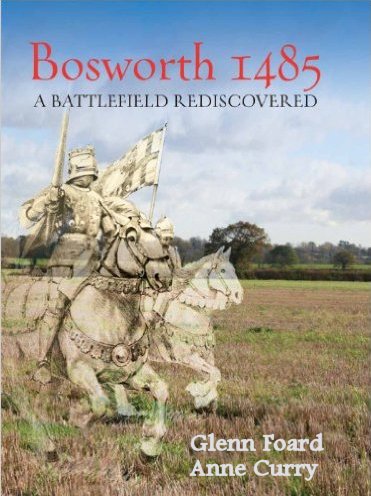
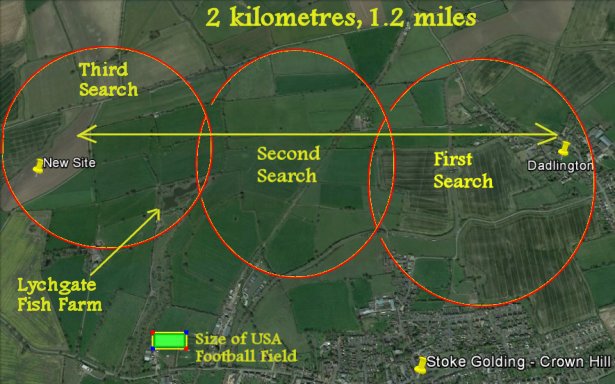
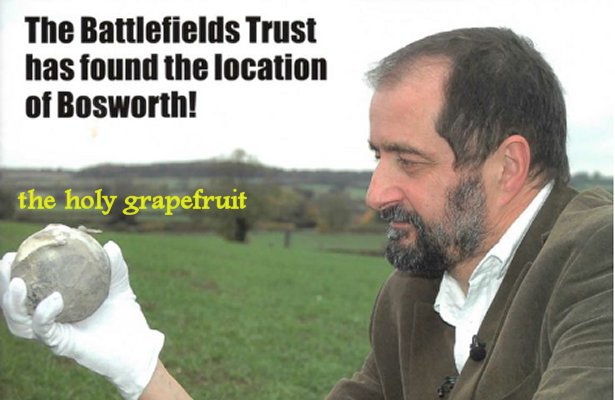
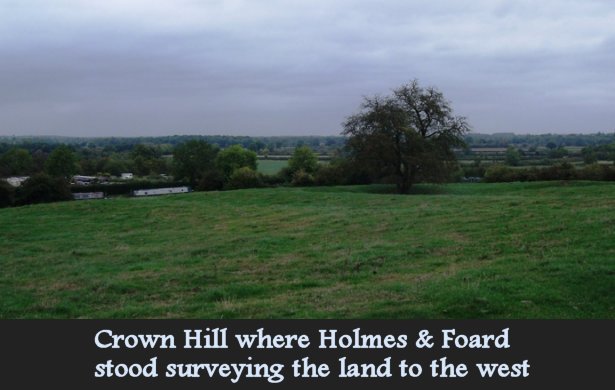
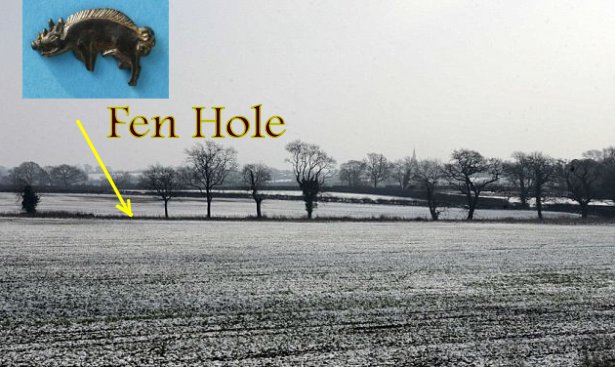
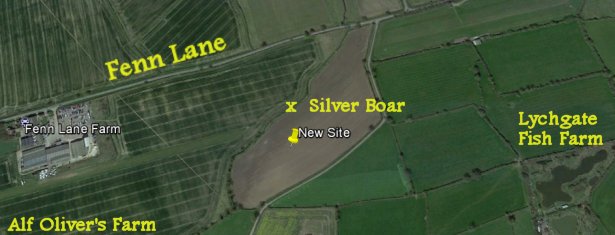
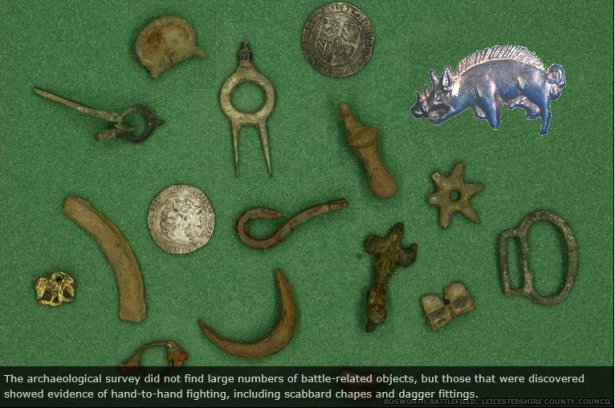
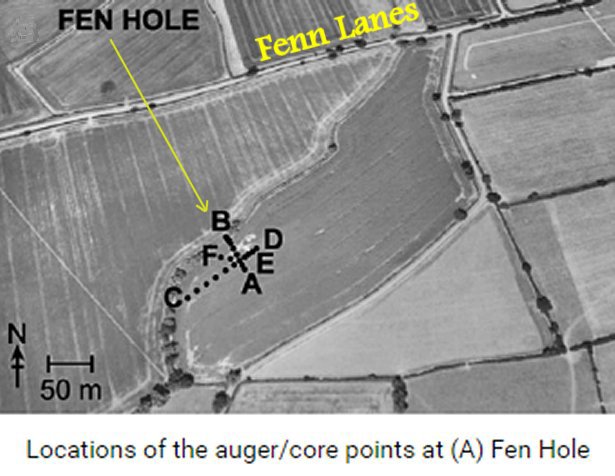
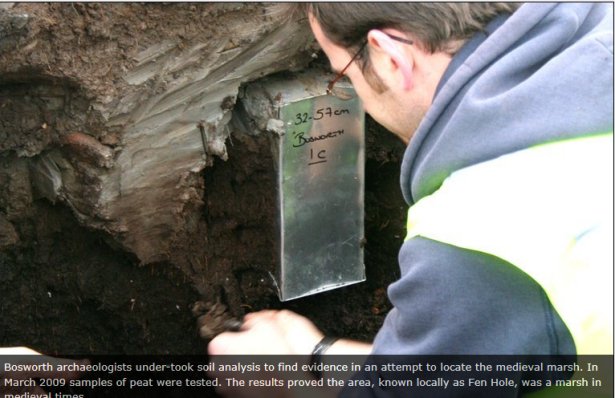
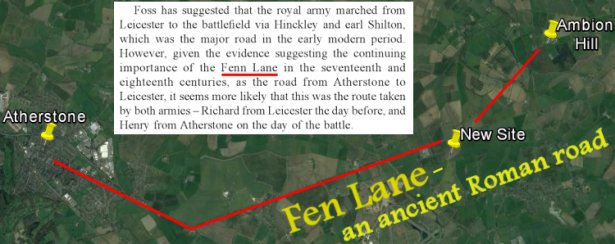
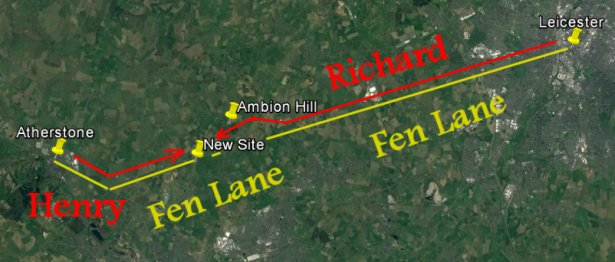
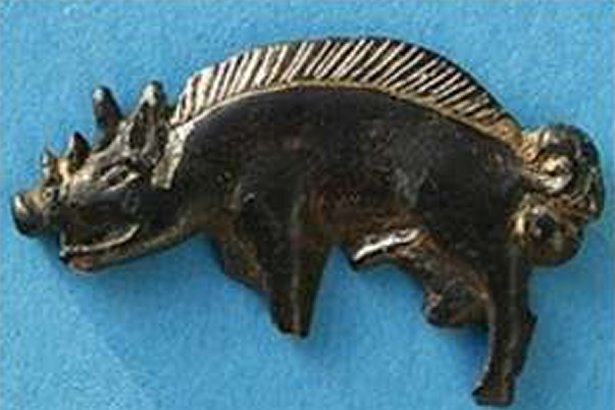
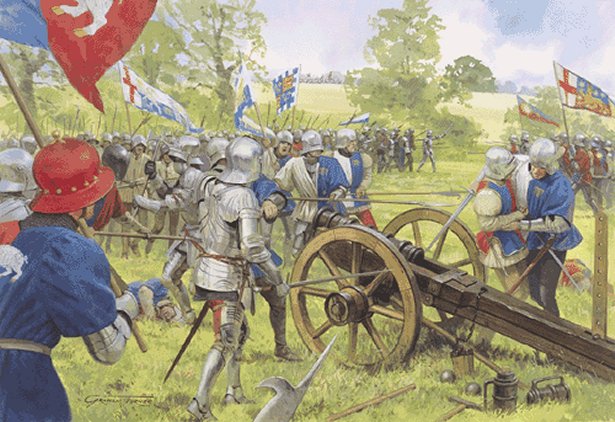 |
| |
|
|
The Story of
Crown Hill
in
Stoke
Golding
|
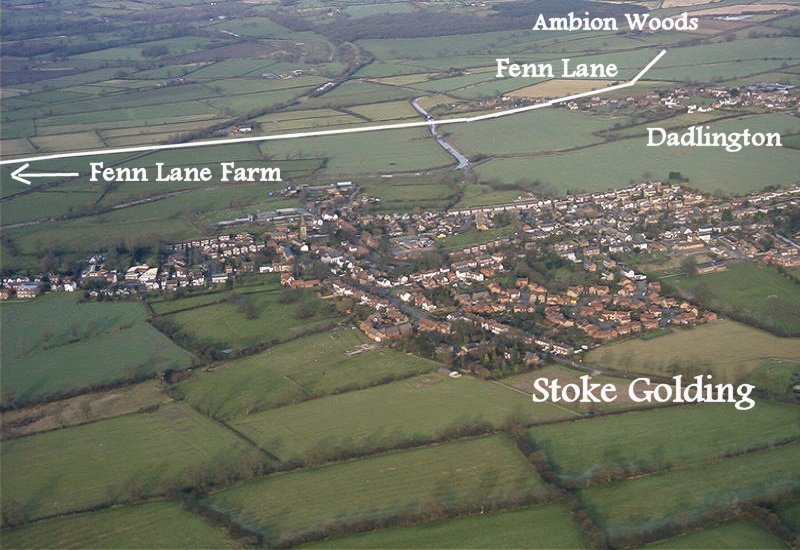 |
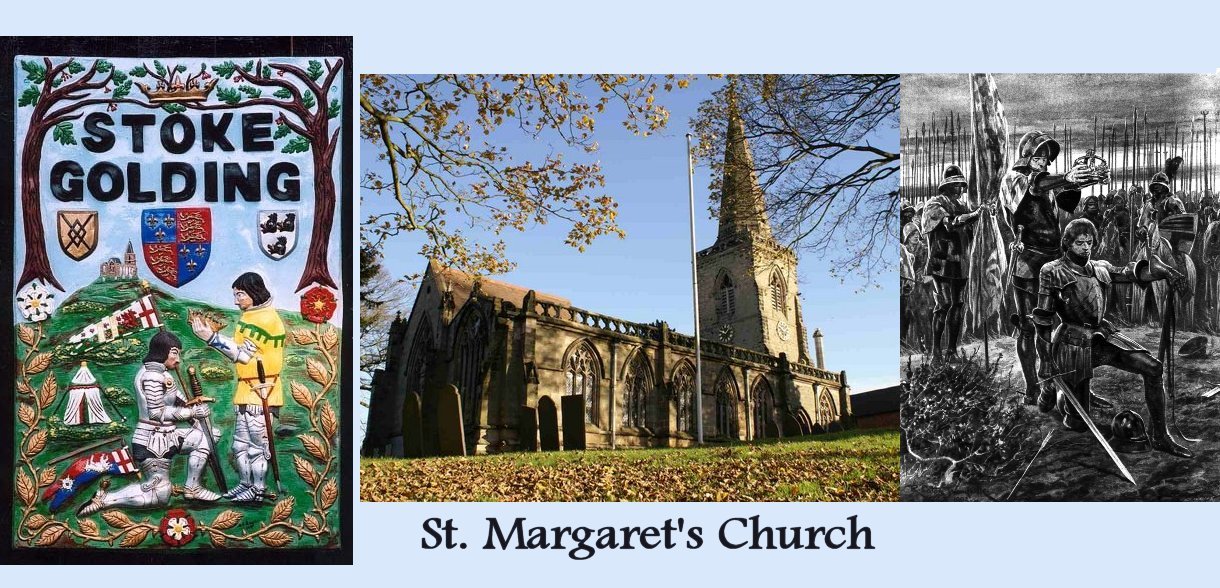 |
In the
Game of Thrones, there are winners and
losers. The same goes for the War
of the Roses.
By
marrying Elizabeth of York, Henry Tudor took the Red
Rose of Lancaster and the White Rose of York and
created the Tudor Rose, a powerful symbol that
portrayed the unification of the warring Houses into
one kingdom. Very clever.
As I
said earlier, the discovery of the correct battle
site will require a major rewrite of the history
books as more facts become clear. For example,
there is the tale of Richard's mighty army dashing
down Ambion Hill, a charge that should have struck
terror into Henry's army. What underdog army
is stupid enough to fight at the base of a hill?
Then
there is that very pretty myth where Thomas Lord
Stanley finally made it to the battlefield, saw
Richard’s battle crown on a bush, picked it up and
placed it on Henry’s head. Then the whole field
knelt to their new king with great reverence.
Very impressive.
The idea
of Henry being crowned by the dominant warlord
Stanley with cheering men and Richard's crumpled
body nearby does create a striking picture.
However, I have a suggestion: forget this image.
This is just one of the many
stories that will need to be rewritten.
The more
likely account suggests Henry was crowned
'King' on Crown Hill in Stoke Golding, a small
hamlet located a scant mile east of the Fenn Lane
battlefield.
So why is it called 'Crown Hill'?
Common sense suggests it was renamed 'Crown Hill'
because Henry was crowned there.
I searched long and hard for a picture of
Crown Hill. I am still looking. The only
picture I could find was taken from a canal boat
taken one
morning from nearby Ashby Canal. (Bosworth, Dadlington, and Stoke Golding are all connected by
30-mile Ashby Canal which is wide enough for small
riverboats to transit.)
This
riverboat picture of St. Margaret's Church suggests
that the town of Stoke Golding is elevated on a
sprawling rise that
I can only assume is 'Crown Hill'. I
was looking for a bump on the horizon, but Crown
Hill is probably more like an wide, flat, elevated
plateau.
If I am
wrong about this, forgive me. As they say, I
am doing the best I can to solve all mysteries
sitting at my computer in Houston, Texas.
In a
way, I can understand the problem that Polydore
Vergil faced when he was writing the history of the
Battle of Bosworth from some library in London.
It was Vergil who gave the Battle of Bosworth its
name because on a map, Market Bosworth was the
closest town to Ambion Hill.
Given
that Market Bosworth is two miles north of Ambion
Hill and Stoke Golding is two miles south of Ambion
Hill, one has to wonder if the Battle of Bosworth
will ever be renamed. Given that Stoke
Golding is one mile from Fenn Lane Farm and and
Bosworth is 3.5 miles, Stoke Golding would seem to
have a better claim to the name than Bosworth.
Plus
Stoke Golding has Crown Hill. What does Market
Bosworth have? Henry Tudor never put one foot
in Market Bosworth during the battle.
Stoke
Golding claims to be the "Birthplace of the Tudor
Dynasty". As we can see from the sign, Stoke
Golding has already started laying claim to
Revisionist History. Will future English
schoolchildren read about the Battle of Stoke
Golding? Or will it be the Battle of Crown
Hill? Has a major battle ever been renamed? One can only wonder.
Glenn
Foard now believes the story of Henry being crowned
in Stoke Golding is the correct one.
"Our
discovery suggests that the Crown Hill story is
probably right, that Henry VII placed the crown
on his head there after one of his soldiers
found it in a thorn bush. We will never know,
but it would have been the obvious place."
Traditionally Stoke Golding is known as the village
where King Henry VII was crowned after the Battle of
Bosworth. It has also recently been
established that the battle took place much closer
to the village than previously thought.
During
the battle, the villagers of Stoke Golding climbed
to the top of the tower of St. Margaret's Church to
watch the battle in the distance. One can
still see the grooves on the window sills where the
archers sharpened their arrows on the night before
the battle.
Henry
Tudor was victorious over Richard III at the Battle
of Bosworth, which took place in the former
marshland known as the Redemore
between Stoke Golding, Dadlington, Shenton and
Sutton Cheney.
After
the battle, Henry's entourage retired to hilly
ground near the village of Stoke Golding, no doubt
to celebrate.
As the
legend goes, Sir Reginald Bray, one of Henry Tudor's
knights, had found Richard's crown in a hawthorn
bush and brought it to the new king. Lord
Stanley then took it upon himself to create the
impromptu coronation using an old table and chair
from a local farmhouse.
Soon
after, this area became known as Crown Hill
and Crownhill Field.
Following its moment in history, Stoke Golding
returned to being a sleepy, farming village.
As the Industrial Revolution crept across England,
small industries grew up including the making of
socks, stockings and shoes. Goods were brought
to the village by the Ashby Canal or the railway
which connected the village to Nuneaton, Coalville
and the North.
Unfortunately, most of the industry has now gone,
although a small trading estate still remains
alongside three pubs, a Post Office, a general shop
and a small marina on the Ashby Canal.
One
would imagine the Stoke Golding chamber of commerce
is visualizing ways to capitalize on its proximity
to Fenn Lane Farm at this very moment. For
example, the village sign proudly shows the two
hawthorn bushes on Crown Hill where Richard III's
crown was said to have been found following his
death. Market Bosworth better watch out.
Incidentally, that boat ride along Ashby Canal looks
like a lot of fun!! That is where you
would find me.
If you
are interested in a visit, I suggest you read this
delightful blog written by a day visitor to the
area:
Saga Run to Battle
At the
end of the day, they stop at the George and
Dragon pub in Stoke Golding for a pint of
ale. You'll find me there too!
As one
gentleman put it, there
are few pubs called the White Boar, after Richard’s
emblem, but dozens of Blue Boars, the emblem of
Henry’s triumphant general, the Earl of Oxford.
Pub signs, like history,
are written by the victors.
|
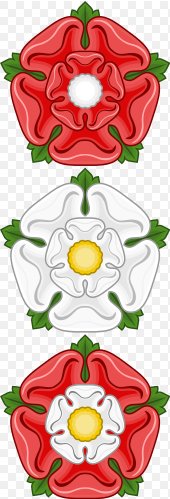
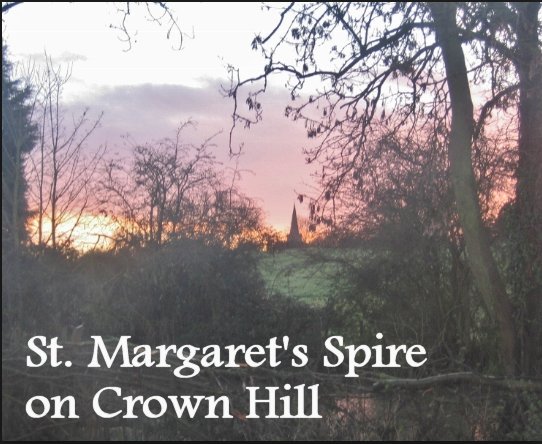
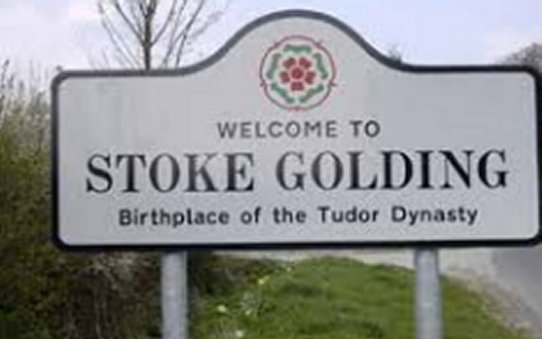
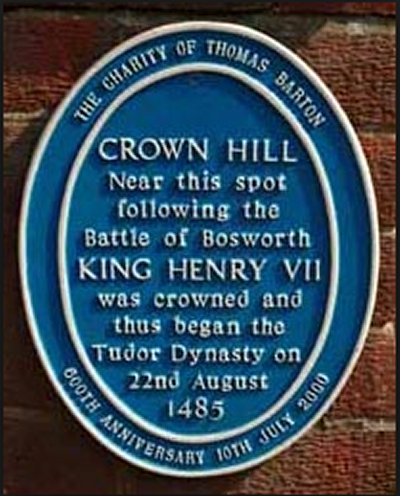
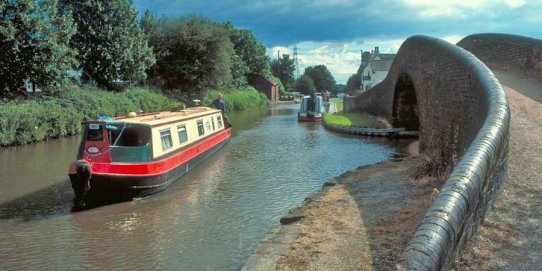
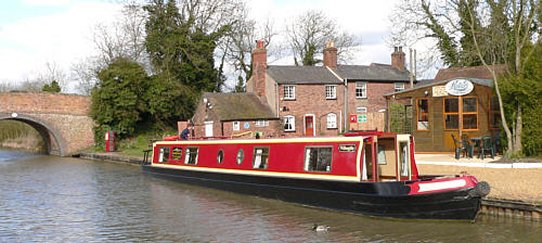 |
The Re-Interment
of Richard III
|
| |
|
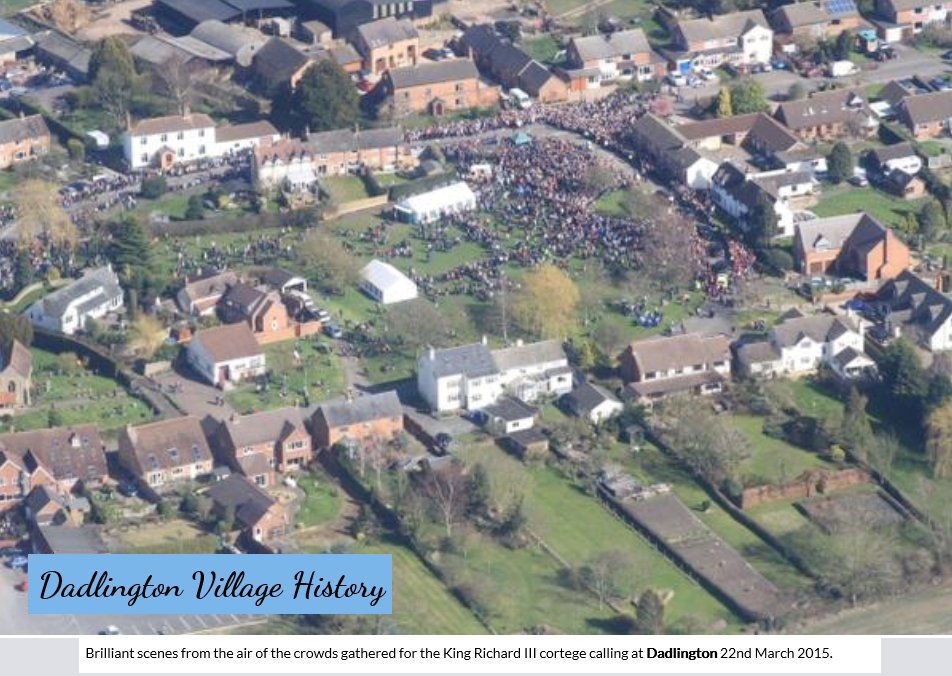 |
This
crowd is watching the funeral cortege of Richard III
as it passes through their town on March 26, 2015.
There is a chance the public's
perception of Richard may be changing.
A mock trial of Richard III, charged with the
murder of the Princes in the Tower, was held in a
full St James’ Church, Dadlington.
The jury (made up of the whole audience) found
the King innocent of all charges.
Unfortunately, I do not know if this report is true
or not.
The
story was
said to be reported in The
Guardian, but I was unable to
find it.
|
| |
|
On March
26, 2015, the remains of Richard III were reburied
in a formal ceremony that stretched from the
battlefield at Fenn Lane Farm to Dadlington and
Stoke Golding all the way back to Leicester.
Although
I wrote earlier about the 2012 discovery of
Richard's body in Leicester, I was unaware at the
time that there had been a 2015 service to rebury
the King's remains. Our story would not be
complete without some mention.
The
ceremony began at noon that day. A hearse
carrying Richard's remains embarked from Leicester
on a 30 mile roundtrip through the English
countryside. Along the way, the procession
made stops at Fenn Lane Farm, Dadlington,
Sutton-Cheney, the 'original battlefield' at
Ambion Hill, Market Bosworth, and four other towns
before returning to Leicester at 6 pm.
At that
point, there was a service held for Richard and then
his coffin was placed into its final resting place.
Philippa
Langley was the woman who spearheaded the campaign
to find the king. As we recall, Ms. Langley
was walking through an empty parking lot in
Leicester when she felt a chill and had a
premonition that she was standing on Richard’s
grave.
Ms. Langley as well as her comrade John Ashdown-Hill
were on hand to witness the ceremony in the church.
Speaking afterwards, Ms. Langley said:
"I
was thinking about all those years ago when I
put the Looking for Richard project
together and its ethos, its aim to give Richard
III what he didn't get when he died in the field
of battle. I was thinking 'Today
it is a job well done'. It really is a
privilege. We are
laying Richard to rest with full dignity and honour."
Historian Dr. John Ashdown-Hill said:
"It
was good to get the sort of reverence for
Richard that he didn't really get in 1485.
Philippa and I and the Looking for Richard
team had been saying all along this is what we
wanted for him."
As for
my personal feelings, I am far
too removed from the details to pass judgment on
Richard's alleged crimes, but I admit I feel a sense
of sympathy for him. Perhaps if I knew more I
would feel differently.
What I
am certain of is that it was shameful the
way Richard's body was mutilated.
Not only
was Richard's dead body struck many times while he
was on the ground, his naked body was thrown over a
horse and carried to Leicester. There his body
lay on a table for days with only a small cloth to
cover his private area while onlookers streamed
past. The worst indignity of all was throwing
his body into a grave without even a coffin.
One has
to assume Richard was hated like a monster for his
enemies to treat him so callously. The
picture tells the story.
I am very glad Richard
received a proper burial. I was touched by the
respect shown by the British people for the reburial
of their fallen King.
I will now share the
rest of this story in photographs.
|
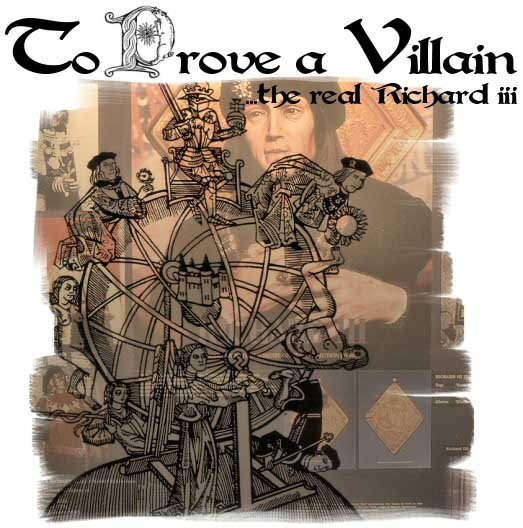
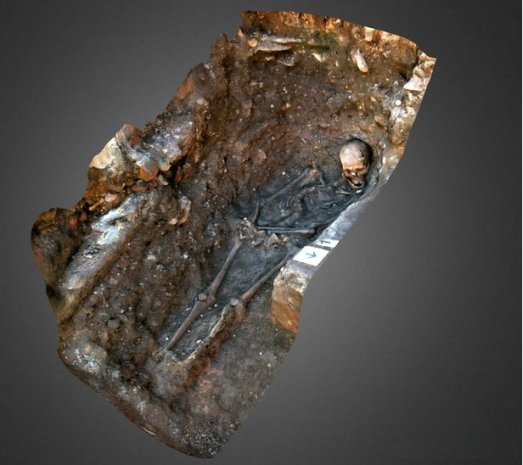 |
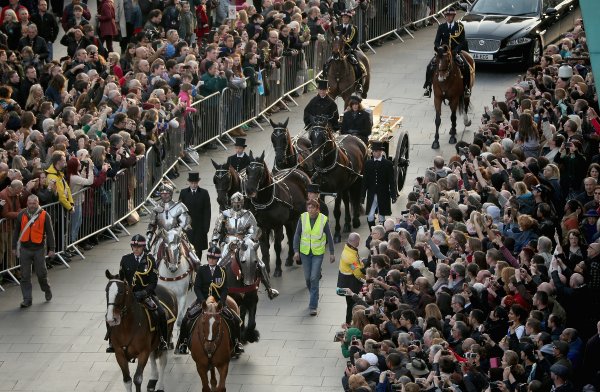 |
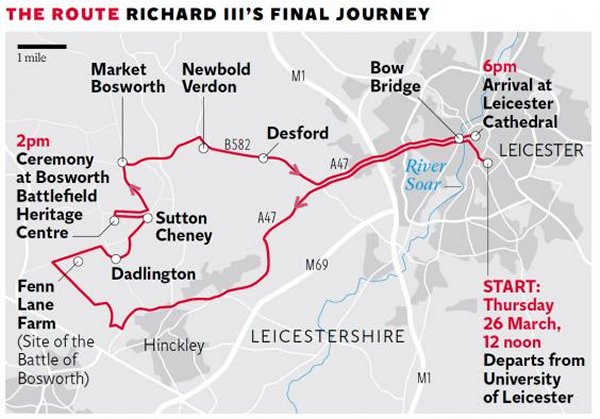 |
| |
|
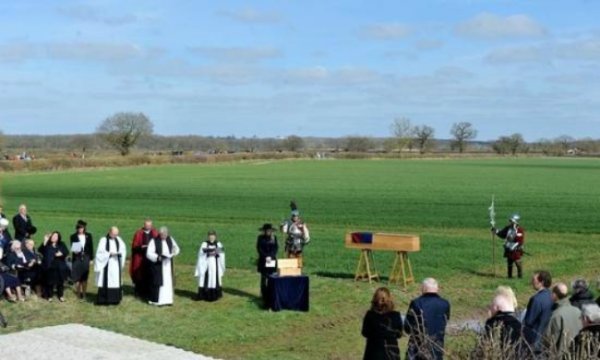 |
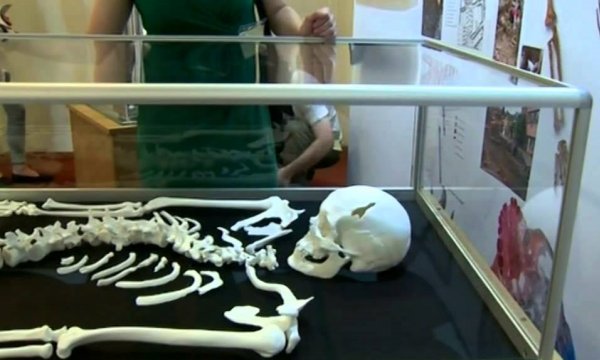 |
| |
|
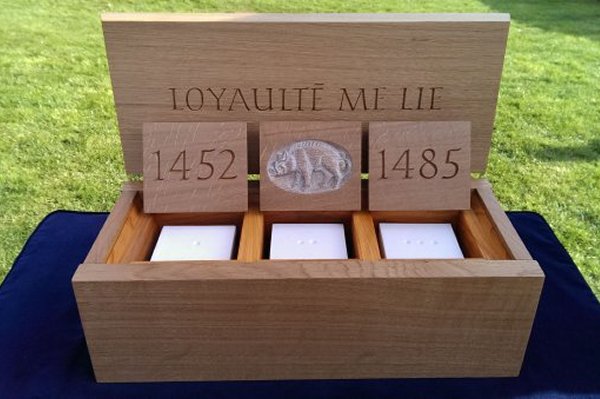 |
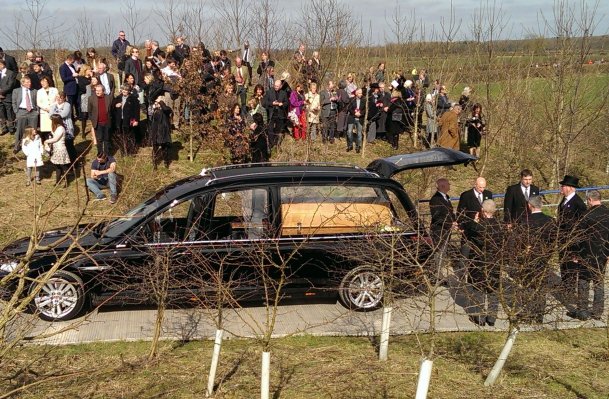 |
| |
|
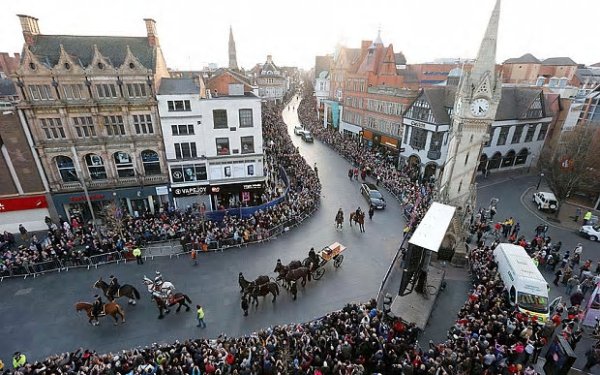 |
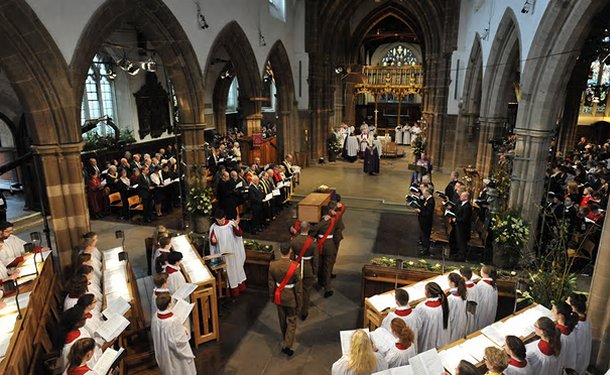 |
 |
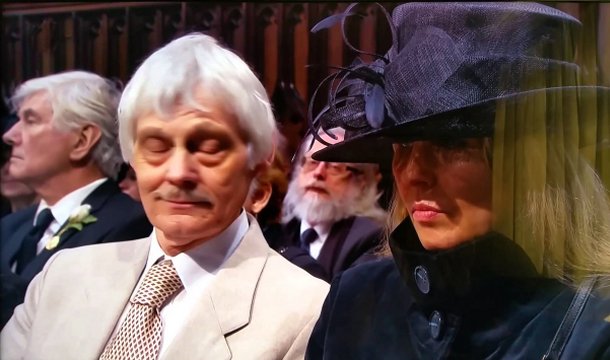 |
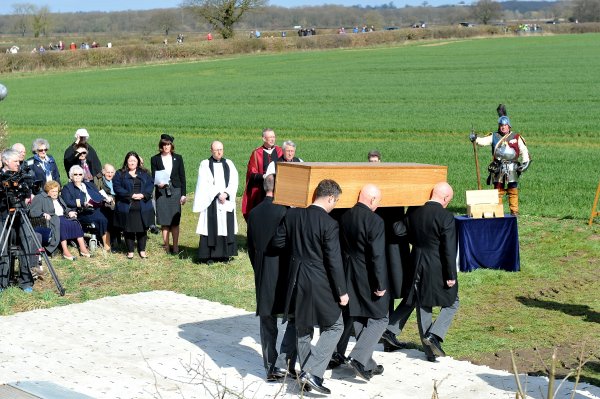 |
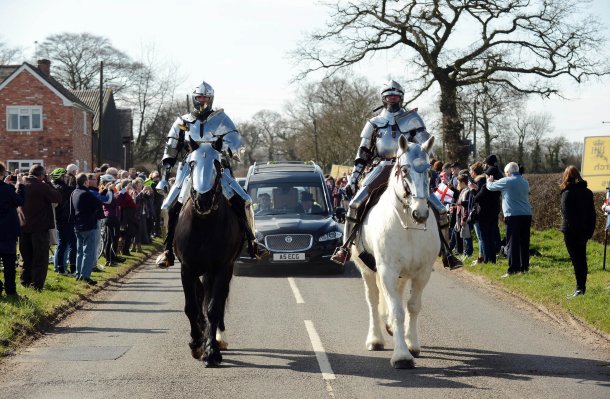 |
Elizabeth of
York was the eldest daughter of Queen Elizabeth Woodville.
If her mother was the White Queen, then by reason the
younger Elizabeth would be the White Princess (incidentally,
there is an April 2017 mini-series on the Starz cable
channel titled the White Princess).
As we know,
Elizabeth of York would marry Henry Tudor and help found the
Tudor dynasty. In fact, the infamous Henry VIII was
her son and the famous Queen Elizabeth was her
granddaughter.
We have read
biographies of one wicked person after another.
Therefore the description of Elizabeth of York as a decent,
talented woman stands in pleasant contrast to all the darker
personalities we have met. Here is a brief excerpt
from an article about Elizabeth by Alison Weir.
(Note: Alison Weir is
Britain’s bestselling female historian, and the author
of 20 books. She has written biographies of Mary, Queen
of Scots, Elizabeth I and Henry VIII’s six wives.)
Elizabeth of York
She may
not have sought the limelight as much as some of her
contemporaries, but Elizabeth of York, mother of Henry
VIII, was a Tudor of rare talent.
Elizabeth of York played an important role in the Wars
of the Roses and the early Tudor story. Born in 1466,
she was the eldest daughter of the Yorkist king Edward
IV, sister of the princes in the Tower, and niece of
Richard III, who had her and her siblings declared
bastards so that he could claim the throne.
The probable murder of her brothers in the Tower of
London in 1483 meant that, in the eyes of many,
Elizabeth was the rightful queen of England. Richard III
himself contemplated marrying her, but in 1485 Henry
Tudor, who claimed to be the heir to the House of
Lancaster and had sworn to marry Elizabeth, came from
France with an army and defeated Richard at the battle
of Bosworth. Thus was founded the Tudor dynasty. The
marriage of King Henry VII and Elizabeth of York was
hugely popular, for the union of the white rose of York
and the red rose of Lancaster was seen as bringing peace
after years of dynastic war.
Elizabeth was intelligent and beautiful. A Venetian
report described her as “a very handsome woman of great
ability, and in conduct very able,” beloved for her
abundant “charity and humanity”. The humanist scholar
Erasmus described her in one word: “brilliant”.
In 1613 Sir Francis Bacon asserted that Elizabeth was
“beautiful, gentle and fruitful”. As time passed,
her husband Henry Tudor clearly grew to love, trust and
respect Elizabeth, and they seem to have become
emotionally close. There survives good evidence
that she loved him, and a moving account of how they
comforted each other when their eldest son, Arthur,
died.
Elizabeth performed her queenly role to perfection,
understanding exactly what was required of her, and
conforming seemingly effortlessly to the late medieval
ideal of queenship, which constrained her to a role that
was essentially decorous, symbolic and dynastic. She was
beautiful, devout, fertile and kind – the traditional
good queen.
Alison Weir
|
 |
There, isn't
that sweet? Finally, a positive opinion about one of
our star players.
So I have a
question. Would your opinion of fair Elizabeth change
in any way if I told you she engaged in voluntary incest
with her uncle Richard III?
The final
episode of the White Queen mini-series had a
naked Elizabeth clearly enjoying a consensual romantic tryst
with Richard III.
Elizabeth Aida
Feola reviewed
Episode 10 of the White Queen
series. Ms. Feola had this to say about Elizabeth's
dalliance with creepy Uncle Dick:
The show capitalizes on a budding romance between
Elizabeth of York and Richard III, started before
Richard's wife Anne has died. Richard says
that there is no actual love between them but we quickly
see that this is not true, as Elizabeth tells Richard,
“I’m in love with you,” and they start kissing.
He
loses his temper and throws her out of court when Anne
dies, because her presence has caused rumors to
circulate that the king has murdered his wife to make
way for his niece, which hurts his honor.
|
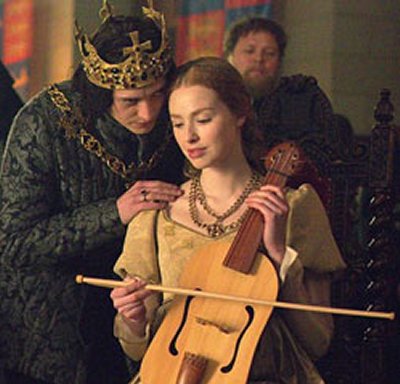 |
| |
|
The origin of this story is from the reign of
James I, based on a letter which is now long
gone, so we do not know exactly what was said
and how much of it was up to interpretation.
Because we don’t know what it said, we are left
to guess.
If the standard of evidence we require
becomes none that say it’s not true, we can make
any statement we wish and stir up doubt.
For example, I can say that when Richard III was
a baby, his father dropped him and that’s what
caused his spine to curve. It’s something
I made up, but since you can’t say beyond a
shadow of a doubt that it didn’t happen, it
quickly becomes accepted as truth.
In five years, students coming into college
courses will ask their professors about how
Richard was dropped as a baby. Enough years go
by, and it’s accepted as fact.
Let me be very clear here- this liaison is not
based on any evidence we actually have. This
relationship is supposed to be romantic, but
it’s disturbing. The papal dispensations which
were granted so that cousins can marry are
twisted to include uncles and nieces, as if this
could have been a viable option. It wasn’t.
Since the pope did not always grant
dispensations to cousins, and I can’t imagine
any pope supporting the marriage of two so
closely related.
This reaches its climax when Elizabeth of York
sneaks out of her mother’s house to Richard’s
tent, to have sex with him. She returns and her
mother smiles at her, as if she were pleased
that they were now lovers. I have only one
reaction to this: EW. It’s disgusting.
Oedipus has nothing on this story.
|
|
| |
|
For the
record, I am not a prude by any stretch of the
imagination. And yet I found myself feeling
unbearably squeamish as I watched this lovely young
woman screw her uncle's brains out. No
reticence, no mixed feelings, no guilt, no
second-thoughts.
As I
watched this beauty writhing in passion underneath
the arms of her uncle, it crossed my mind that this
man was accused of murdering the girl's two
brothers. It was this man who took her brother
Edward's rightful place on the throne. It was
this man who had declared her a bastard child and
had slandered the reputation of both her father and
her mother. Plus Richard was her uncle.
Based on her mother's famous fertility, Elizabeth
was risking getting pregnant with this incestuous
liaison. This was very dangerous game she was
playing.
So did
this tempestuous Mambo #5 really take place or did
someone make this up?
The vast
majority of the web sites that choose to comment all
cast strong doubt on the likelihood of this
relationship taking place. If you wish to have
a detailed explanation of the doubt, I recommend an
excellent
article written by Olga Hughes.
Here is
a direct quote from Ms. Hughes' article:
To gratify an incestuous passion… While we
have seen several entirely imaginary depictions
of romantic love between uncle and niece in
fiction recently, the one thing we can almost
positively rule out is sexual intercourse.
If you
prefer a more succinct explanation of doubt, our
friend historian John Ashdown-Hill listed this 'relationship'
as the third myth in his article '6
myths about Richard III'.
If I had
to place a bet, I would put my money on Myth #3
before Mambo #5.
|
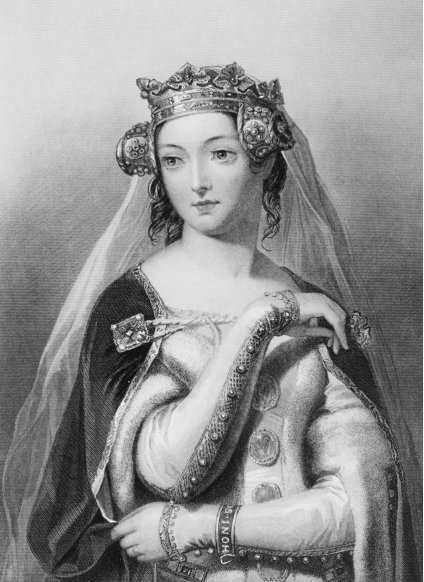 |
While it is true
that good, decent folks are hard to find anywhere in the
vicinity of the events in the White Queen, I would like to
say I was deeply offended by the sex scene between Richard
and Elizabeth. If it had been Burton and Taylor, fine,
I can accept adultery, but incest is a much more serious
matter. This scene crossed so many social taboos I
don't even know where to begin.
Elizabeth Aida
Feola made this comment:
If the standard of evidence we require becomes
none that say it’s not true,
we can make any
statement we wish and stir up doubt.
For example, I can say that when Richard III was a baby,
his father dropped him and that’s what caused his spine
to curve. It’s something I made up, but since you
can’t say beyond a shadow of a doubt that it didn’t
happen, it quickly becomes accepted as truth.
In five years,
students coming into college courses will ask their
professors about how Richard was dropped as a baby.
Enough years go by, and it’s accepted as fact.
I happen to completely agree with Ms. Feola's comment.
In fact, I was so impressed with it that I made up a fib in
her honor.
Earlier when I
wrote about the scoliosis of Richard III, I added this
statement:
It turns
out that Richard had adolescent onset scoliosis, a
curvature of the spine. In other words, the
deformity wasn’t present at birth, but developed after
the age of ten. This lends strong support to the
story that
George, Richard's older brother, pushed him down a
flight of steps during a fight between the two boys.
The resulting injury likely triggered the
onset.
There is no story
about George and Richard having a fight. I made it up.
Nor is there any story about how Richard was dropped as a
baby. Elizabeth Feola made it up. But both
scenarios are not only quite believable, I imagine someone
will read my statement and actually buy it... and quite
possibly as years go by, it will be accepted as fact.
I can just see
it now. Some high school kid writing about Richard III
for his term paper will quote me...
"Richard
Archer, in his ground-breaking Internet article 'Brexity
and Brevity', stated that when Richard III was 10,
he was pushed down a flight of stairs by George, his
older brother.
Mr. Archer goes on to state that this
injury caused the onset of adolescent scoliosis.
As we know, it was this scoliosis that caused
Shakespeare to humiliate Richard for the ages with his
so-called hunchback..."
I am absolutely serious - people read my stuff and believe
it! I even have proof.
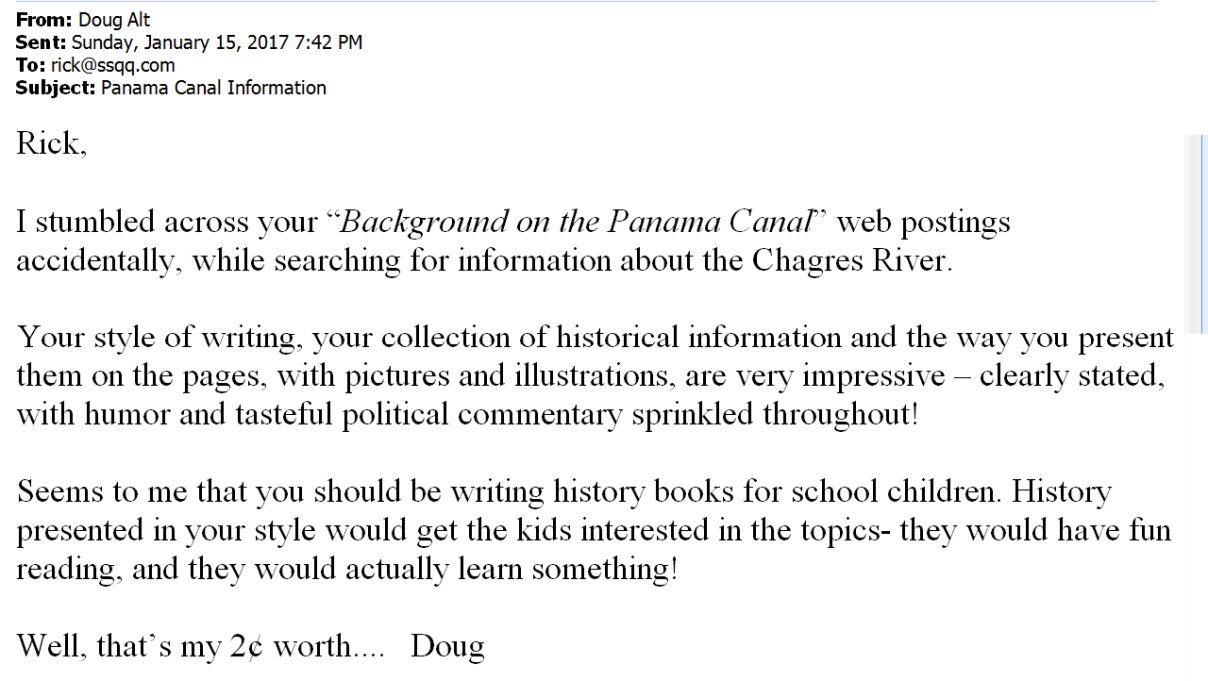
This kind gentleman is referring to my
History of the Panama Canal. It is
always nice to get compliments, but then a high school kid
actually does read my stuff and the first thing they do is
ask for my credentials!! Too funny.

Emily is a smart girl. She may be young, but she can
already spot a BSer like me a mile away. However, here
is the problem... not everyone is as careful as this young
lady who asked whether I was qualified to write my 'History
of Germany' article. I was actually proud
of her for asking if I had credentials! I wish more
people were skeptical. By the way, in case you are
curious, no, I don't have any credentials. What do you
expect from a retired dance teacher?
So here is my question: Did you catch it back when I
fibbed about Richard's scoliosis accident? I would be
shocked if you did.
I hate to
criticize my wonderful readers, but I seriously doubt any of
you
thought twice about it. I know for a fact I would not
have caught a throwaway comment like that. It is very
plausible that George was a bully. It is also very
plausible that someone dropped Richard as a baby.
Heck, one time I dropped my own daughter on her head when
she a baby! (She made it to graduate school, so I
guess she's okay, but still...)
So let me get to
the point - I believe very few people seriously question the
things they read and see. So when the White
Queen showed Elizabeth having sex with her Uncle
Richard, I imagine 4 in 5 people walked away assuming it was
true.
Let me say this
again:
I
personally believe that many of the people who watched
the sex scene between Elizabeth and her uncle left the
show believing that incident really took place.
That offends me because I don't think it happened and I
don't think those kind of lies have any business being
portrayed as historical fact.
Please read the following Internet exchange. It
details a conversation where a person is just as confused
about the Elizabeth-Richard relationship as I was.
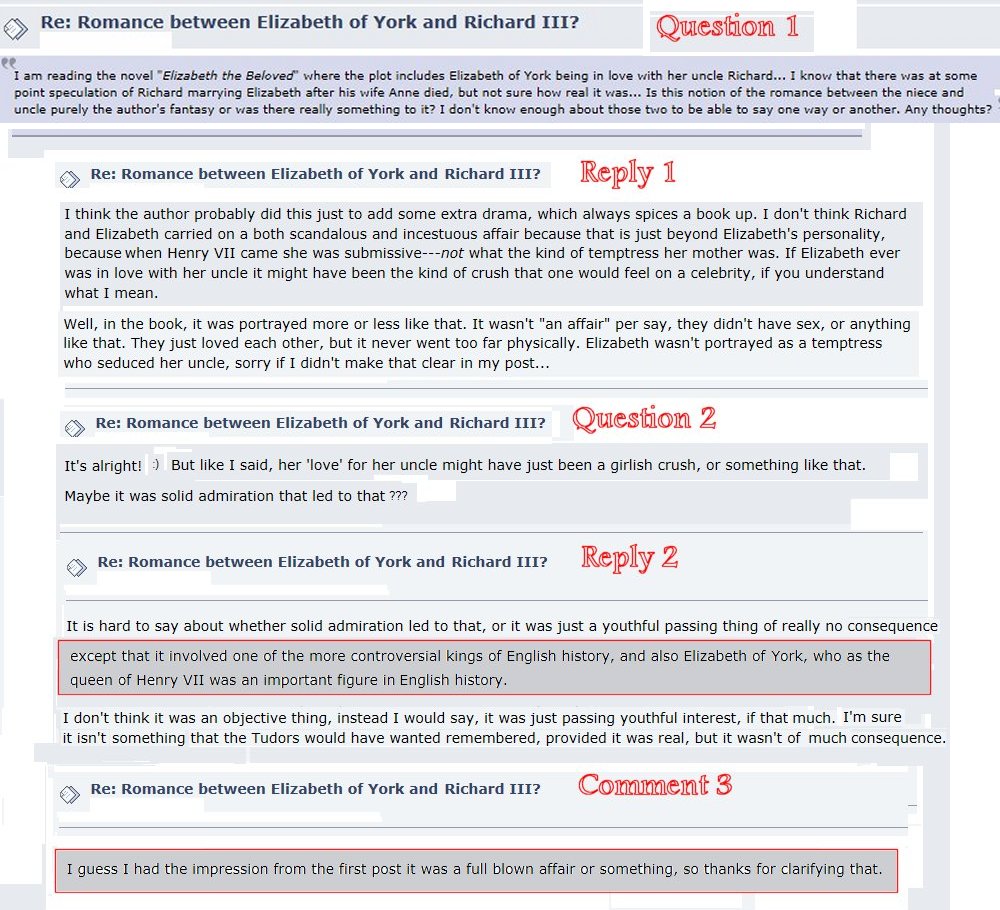
As one can
guess, this is an exchange between a person who is taking
the time to actually check out allegations that trouble her
with a more knowledgeable friend. How many people do
that? Right now the majority of the human race is
overwhelmed with so many Internet choices that we have all
become numb. Fact-finding is a huge chore. For
one thing, who are we supposed to believe? It took me
two hours... TWO HOURS... to read up on the story of incest
between Richard and Elizabeth. I am retired, so I have
that kind of time. But the majority of people do not
have that kind of free time (or the inclination) to check
things out.
It is one thing
to make a goofy statement that Richard got dropped on his
head as a boy, but it is another thing entirely to write a
TV scene where millions up TV viewers watch the future Queen
of England commit incest with her villainous uncle.
This upsets me
because there are a lot of people out there who do not
question a damn thing they read or see on TV.
Enough
years go by, and it’s accepted as fact...
When writing
about history, why can't people do their best to tell the
truth?
I believe making
stuff up can cause irreparable damage. You don't
believe me?
William
Hutton (1723-1815)
famous book "The Battle of Bosworth"
was published in 1788. Although
this book was widely criticized at the time, over
time Hutton’s work became the account upon which
most theories were based.
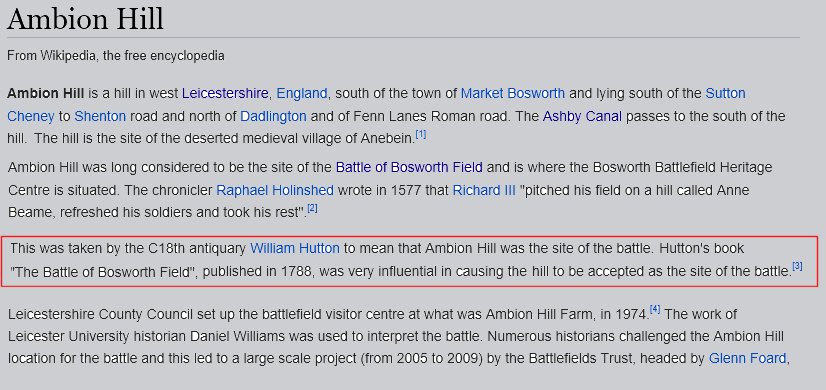
Enough
years go by, and it’s accepted as fact...
"except that it involved... Elizabeth of York, who as
the Queen of Henry VII was an important figure in
English history."
We can
make any statement we wish and stir up doubt.
Did you
know that Donald Trump believed his celebrity status
gave him the right to touch the private area of any
woman he found desirable without asking permission?
Did you
know the rumors about Barack Obama being a secret
Muslim are true?
Did you
know that Barack Obama was born in Zimbabwe, not
Kenya as previously thought?
Did you
know that Hilary Clinton worked her way through law
school as a call girl?
Did you
know that Bill Clinton secretly executed dozens of
witnesses to his many affairs?
Did you
know that Benjamin Franklin participated in French
sex orgies?
Did you
know that Abraham Lincoln had sex with a freed slave
in the Oval Office?
Did you
know that Abraham Lincoln was secretly a vampire
hunter?
Did you
know that Thomas Jefferson fathered several children
with a slave girl?
Did you
know that Franklin Delano Roosevelt and Winston
Churchill had a homosexual relationship?
Did you
know that Eleanor Roosevelt was a lesbian?
Did you
know that George Washington owned a plantation full
of slaves?
Did you
know that Frank Sinatra and John Kennedy had a
three-way with Marilyn Monroe?
Did you
know that at least one of these statements is
actually true?
For the record, I take no
pleasure in repeating these rumors. I have never met
any of these people, so what gives me the right to say these
things? After all, I don't have the slightest idea as
to the validity of these rumors. But why should I feel
guilty? People pass ugly rumors like these on all the
time and never think twice.
We can
make any statement we wish and stir up doubt.
As it stands, some people who write historical fiction think
they can say anything they want with impunity. I say
that is wrong.
Although I
believe that
historical fiction has a duty to be factually
accurate, there are many who disagree with me.
The Internet is filled with authors (who shall go nameless)
who claim that historical novelists have the right to use
"poetic license".
To some extent,
I agree, especially where dialogue is concerned. For
example, I created dialogue at certain points in my article
as an effective way to make a point. In particular, I
found this to be a useful technique when writing about the
absurdity of Owen Tudor, the servant who bedded a Queen.
But there has to
be limits. Just because it is 'legal' doesn't
make it right or ethical. I am good with 'speculation'.
However, I am not good when people assert things to be
true... such as the incest between important historical
figures.
By the way, 'Did
you know that Franklin Delano Roosevelt and Winston
Churchill had a homosexual relationship?'...
I made that rumor up just now. I could just as easily
discussed the time that Richard Nixon molested his nubile
teenage daughter Julie in her White House bedroom. I
made that one up as well.
What is stopping
me from writing historical fiction about Winston Churchill
(a man I admire, incidentally) and using 'poetic license'?
Winston
Churchill came aboard the American heavy cruiser USS
Augusta where Roosevelt and his staff were waiting. On
first meeting, Churchill and Roosevelt were silent for a
moment until Churchill said 'At long last, Mr.
President', to which Roosevelt replied 'Glad to have you
aboard, Mr. Churchill'.
The two
men hit it off immediately. With so much to
discuss, they retreated to wood-paneled library where
they could speak in secrecy. Talking late into the
night, a rapport developed that involved two men
burdened with saving the Western civilization from a
monster.
Perhaps
it was the bourbon, perhaps it was the pressure, but at
this point Roosevelt placed his hand over Churchill's.
'It is getting late, Prime Minister, let us retire to
bed.'
'Where do
you wish for me to sleep, Mr. President?'
'Will my
bed be acceptable, Winston? That way we can
continue our conversation much further into the
night...'
'Yes,
Franklin, I concur. We have so much to talk
about...'
Before some school kid quotes me on that paragraph, let me
reassure everyone that I have no knowledge that any such
event ever took place. But let me also add it was
really easy to write that paragraph. Isn't 'poetic
license' fun?
I contend that
my imaginary story about Churchill and FDR is NO DIFFERENT
than the story about incest between Richard and Elizabeth.
The only thing
stopping me from writing historical fiction lies is
integrity and discretion. Without those qualities, in
the hands of an unethical hack, 'Poetic license'
becomes an excuse to slander an otherwise remarkable
historical figures!
An intelligent
writer should be able to have their cake and eat it too.
Lawyers have a term... 'admissibility'. This
term deals with the rules regarding admission of evidence.
The same should hold for historical fiction.
Take, for
example, this issue regarding incest between Elizabeth and
her uncle. There is little proof that it took place.
Nevertheless, someone took it upon themselves to portray on
screen that this forbidden hookup took place. I can
attest the shock and disgust has yet to wear off in my
brain. Now I am intelligent enough out to check it out
and so are you... but there are many people who swallowed
the scene hook, line, and sinker.
Whatever
happened to taste? A more delicate way to introduce
this idea would be to have a debate. Let two
characters close to the situation argue and speculate as to
what might be going on between Elizabeth and Richard.
This way they can raise the 'possibility' without
necessarily condemning. I think writers and portrayers
of historical fiction have an obligation to inform their
readers in some way or another when they decide to stretch
things a little too far. Try using some 'discretion'.
There are some
who say that 'gossip' is the most powerful force on
earth after gravity and the atom. Others say a lie
makes it halfway around the world before truth can put it
pants on. I could tell half the people on earth that
they are too gullible and they would believe me. It
all needs to stop. There is too much false information
in the world to begin with for unethical writers to spread
even more.
In particular,
as for Elizabeth of York, unless the writer and director had
undeniable proof, whoever decided to slander the Queen of
England should be ashamed of themselves.
I have a
suggestion. From now on, anyone convicted of spreading
false historical fiction shall have their names slandered
upon their passing. That way, if there turns out to be
an afterlife, they can see what it feels like having their
own reputation smeared.
Poetic justice
for poetic license.
|
What's
Next for the Bosworth Battlefield?
|
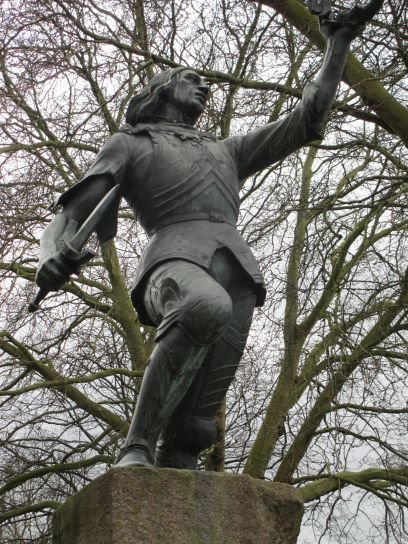 |
Well,
thank goodness there are some people with inquiring
minds. Thanks to the efforts of those who
challenged the brainwashed thinking of the men who
placed the battle site at Ambion Hill, they finally
got it right. I imagine the
success of Dr. Foard in locating the correct
battlefield at Fenn
Lane Farm had a direct effect on Philippa Langley's decision to pursue her 'Looking
for Richard' project. The dual
discoveries of the correct battlefield and the
correct burial site make for one of the most
remarkable stories I have ever come across. So
now the question
is: What happens next??
England is
behind the times in showing proper
acknowledgment to its historic battlefields.
American
battlefields are carefully preserved and
properly displayed, yet
England's
great battlefields are hardly covered at all.
Routine old cottages have statutory
protection, where the places
were the nation’s history was decided
are
good spots
for new highways.
Britain
is covered with such sites, yet they are largely
ignored. Although there
is a
promised government bill on this issue,
it has not
materialized. There are
only two other battle centres in England
comparable to Bosworth: Hastings (1066) and
Shrewsbury (1403).
I found
a curious anecdote regarding Leicestershire Council anxieties
during the search.
One
theory was that the battle might have been
fought much farther away,
even as far as Warwickshire. Mr.
White, councilor in charge of building the
centre, was particularly relieved.
“My leader said: ‘Whitey,
if it turns out to be in
Warwickshire, you’re sacked.’”
Now after four years of
considerable uncertainty, with the discovery of
Fenn Lane, they have resigned themselves to a
rewrite of interpretative signboards and
modification of their exhibits. Otherwise, they
are putting a brave face on the situation. “You
wouldn’t want a centre slap-bang in the middle
of a battlefield,” said curator Richard Knox.
“It would ruin the archaeology and the ambience
of it.”
|
| |
|
Before we continue, a long time ago I asked you to
find Waldo and memorize a word. Do you
remember what that word was?
|
| |
|
As Dr.
Glenn Foard kept edging further and further to the
west, one can imagine the fear preying
on the minds of the people who depend on the
Bosworth Battlefield for a living. There was
an air of resignation in these people. Back in
2009, it was a foregone conclusion that Ambion Hill
was not the real battlefield. Now the question
was just how far away the correct battlefield would
be.
It was
clear that Dr. Foard was going to find this
battlefield eventually. But every time Foard
moved one farm further to the west, the increasing
distance began to grate on the nerves of the
Bosworth Battlefield dependents.
|
|
|
|
|
|
 |
Finally
Dr. Foard struck pay dirt at Fenn Lane Farm.
Talk about lucky!
It
wasn't exactly 'close' to Ambion Hill, but at least
it was within viewing distance. The Leicester County Council
had dodged a
huge bullet.
The news could have been
so
much worse.
There
seem to be plans to keep the Visitor Center where it is and
let people stroll to the new location of the battle.
In the long run, the
weird publicity
might even prove
good for business.
The
Leicestershire County Council
is negotiating with landowners to gain full public
access to the area.
In fact,
the Bosworth Battlefield Heritage Centre told
the BBC that the new site is "within
walking distance" of the Bosworth
Visitor Center.
'Walking
distance'?
Were these people serious?
Did they really believe 'Walk' was the
solution to their problem?
|
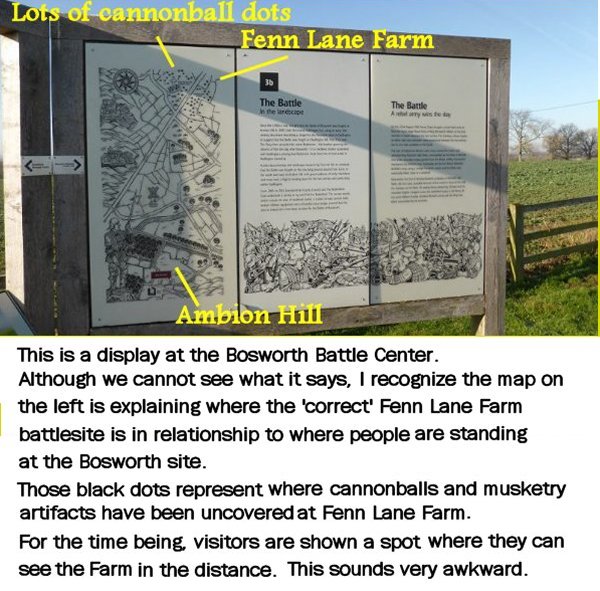 |
|
|
|
|
|
|
I loved
this quote:
Officials are planning to rewrite the
interpretative signboards and modify part of the
exhibition. Otherwise, they are putting a brave
face on the situation.
“You wouldn’t want a
centre slap-bang in the middle of a
battlefield,” said curator Richard Knox. “It
would ruin the archaeology and the ambience of
it.”
Mr. Know was referring to 'interpretive
signboards' such as this one. This is a
photograph taken of a sign that is part of the
Bosworth Battlefield walkway. As one can see,
people are encouraged to walk for one hour around a
one and a half mile trail to look at signs tell the
story of the battle.
Mr. Knox
is surely in a bad spot. Can you
imagine how utterly embarrassing it is to represent
a battlefield that doesn't exist?? Once
upon a time they wanted to be the next Stonehenge.
Now they just want to stay relevant. Never before has such a weird
challenge presented itself.
In a
way, I feel for the Bosworth people such as Mr. Knox. They have
created all these wonderful explanation signs, but
now they are faced with the fact that much of it is
wrong.
For
example, there are pictures of Richard
charging down the hill. That is nonsense.
We now know the battle was fought on a plain.
There are pictures of Richard dying in a marsh at
the foot of the hill. Complete fiction.
There was no hill.
Their elaborate 1.5 mile
Walking Trail
is obsolete. It must seem very unfair, but
harsh reality dictates that the History of the
battle
will have to be re-written. However, that's
the easy part.
The hard part is that the Walking Trail
will need to move to the new site.
|
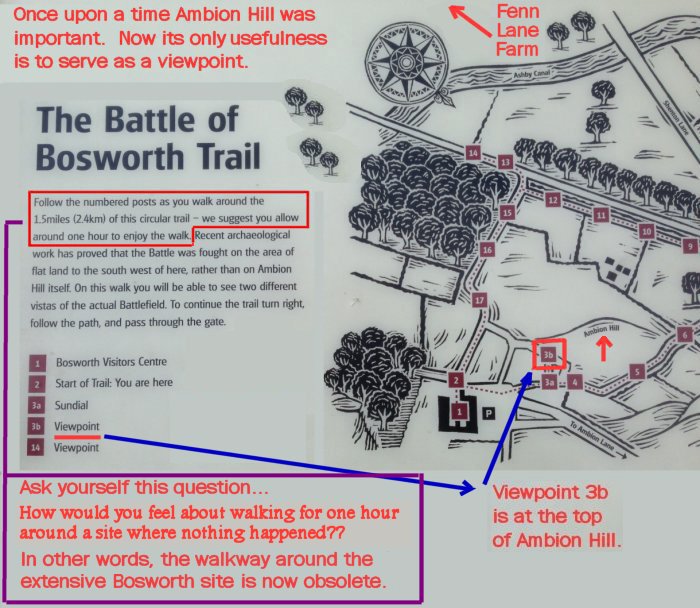 |
If the Walking Trail moves to
the new site, now we are looking at three
walks... one walk to get from the old site
to the new site, a long walk around the new
site, and then another walk back to the old
site. That sounds like a lot of
walking.
Now Mr. Knox is correct about one thing...
no one wants the Visitor Center in the
middle of the battle field.
However, there is a concept known as 'Reasonable
Distance'.
Based on my experience, 'Reasonable
Distance' is about 100 yards for
American tourists who believe the length of
a football field is God's idea of a healthy
walk. Their absolute upper limit is
300 yards. Anything further than that
is out of the question.
So what makes me an authority?? Throughout my
article, I have freely admitted I know little about
English history. However, if there is one
thing I am an authority on, that is walking.
My wife and I walk all the time on our
cruise trips. I love history and I
have found the most fun way to learn history
is to travel and visit other countries.
Unfortunately, not much is learned from a
bus. My wife Marla and I have learned
it is much better to Walk.
That way we can take pictures, study maps,
ask questions, and read whatever literature
is available.
Our cruise trip to England and the British
Isles will be our 40th cruise trip. After 40
cruise trips, I have learned that the average
vacationer does not like to walk. In fact, the
less they walk, the happier they are.
|
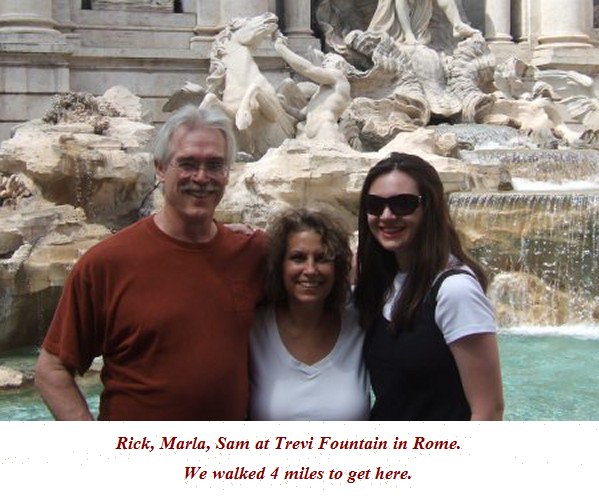 |
|
|
|
|
You
might be curious what this picture represents.
That is
a picture of Cozumel, Mexico, the most successful tourist
trap in the Western hemisphere. The entire
scheme is absolutely brilliant. Every day 6 to 8 cruise ships dock at 3 different piers.
20,000-40,000 passengers have no choice but to enter
a maze-like village of shops and bars. Yes,
there is an exit, but the only way to find it is to
ask for help. I have found that is when no one
seems to remember how to speak comprehensible
English.
Most
people don't bother asking for help. They
wander around aimlessly assuming they will find the
exit sooner or later. For some reason, they
can't seem to find a way out of the village.
Pretty
soon they get hot, thirsty and hungry. They
are getting really tired of looking for the way out.
They have wasted over an hour and now time is
running out. So they give up and buy a bunch
of tee-shirts just to prove they visited Mexico.
Then they hit the nearest bar and get smashed on
margaritas and chips.
Drunk
out of their minds, these people can still get back
to their ship because their ship is bigger than most
football stadiums. A convenient horn blast
tells the bartenders when to shove people out of the
bar. Fortunately, the tourists don't have far
to go.
The
village is
less than 300 yards from each cruise ship. And you
know what? Every trip I take to Cozumel,
someone has the nerve to complain the walk was way too
far.
300
yards is the absolute limit. I kid you not.
|
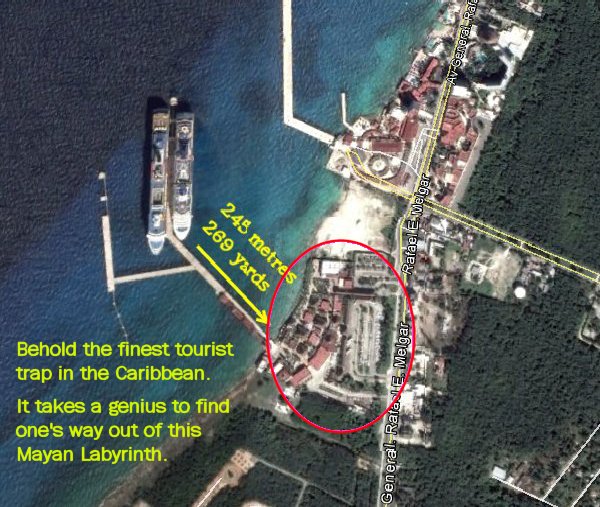 |
| |
|
 |
The
Distance from Ambion Hill to Fenn Lane Farm
So I imagine you are beginning to wonder
what the walking distance might be from
Ambion Hill to Fenn Lane Farm.
Funny you should ask.
Through the magic of Google Earth, I
measured the distance.
Let's see how far it is.
|
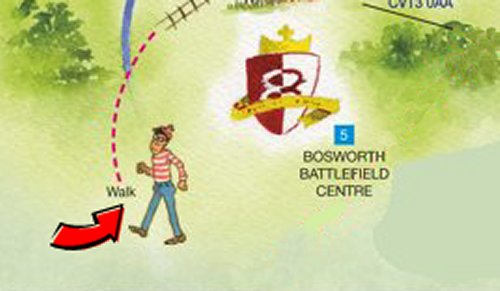 |
|
|
|
|
The
answer is four miles.
If the
Bosworth Battlefield Heritage Centre
thinks the general public is willing to walk a
four-mile round trip, they are out of their minds.
This is
much too far for the elderly and this is much too
far for children. Even for young adults and
middle-aged people, four miles is still much too far
if they have their family with them.
For that
matter, what about time constraints? An
athletic pace gets this done in 45 minutes.
Normal people closer to an hour. Round trip
becomes 90 minutes to two hours. Budget
another hour to walk around the new Fenn Lane Farm
Walking Trail.
How many
vacationers have the luxury of investing two to
three hours in a round trip hike from the incorrect
battlefield to the correct battlefield, then back
again?? My guess is they would whisper
the unthinkable... 'Why not put the museum and
the parking lot where it belongs at Fenn Lane Farm??'
Obviously the English are made of hardier stuff than
your average Caribbean cruiser, but I daresay at the
minimum they
will back off from this walking strategy soon enough.
I
predict the future Battle of Bosworth experience
will come complete with shuttles or even a mini-train.
Make it a Disney ride and let people have some fun
out of it. How about a roller coaster.
Or a two-mile zip line?
Or better yet, maybe they will ferry people back and
forth on the Ashby Canal. The cruise people
would like that.
|
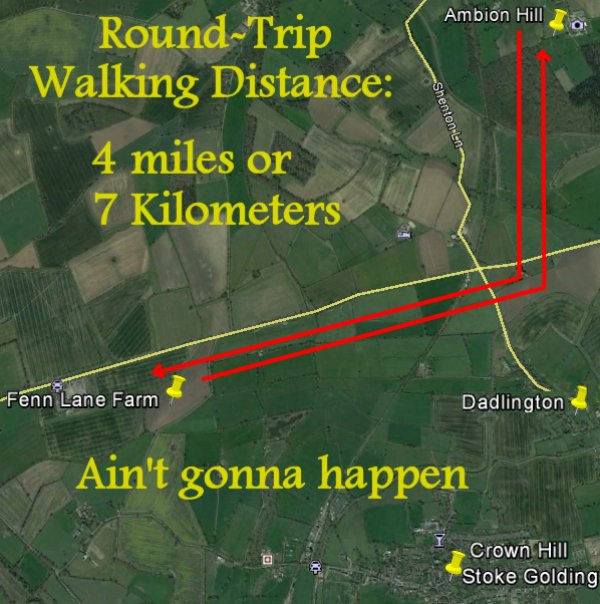 |
The Reputation of Richard III
|
| |
|
On the Negative
Side...
Rick
Archer's Note: I don't know much about
English politics, but I gather that The
Guardian likes to be controversial.
This magazine/newspaper had some pretty mean things
to say about the Royalty... and Richard as well.
Britain mourns a
Monster
– Because he was a King.
Richard III’s burial was absurd!
Polly Toynbee
The Guardian
|
 |
Surely it’s time
to make King Richard pay his dues. We’re often told
the royals are good for the country because they
raise our international profile and encourage
tourism – so we should be wringing every penny out
of Richard III. We’re
missing a trick here. Several tricks in fact.
For starters, we’re not even burying him during
tourist season. After 500
years, surely he can wait another month or two.
Or
better yet, why rebury him
just once?
Why not make it a regular event, like the changing
of the guard? If it is true
the Royals improve tourism, then let's put Richard
to good use. Dig
Richard up at the start of each month,
hide the
individual bones at random beauty spots around the
countryside, and turn it into a
giant treasure hunt for
tourists. Follow the
clues on an accompanying app; see if you can locate
his skull. Congratulations! It
was hidden in a bin behind Oblivion at Alton Towers.
Now track down his elbow. Then his pelvis.
First to find six
bones receives 20% off their B&B bill and a
family-size jar of Marmite.
Pinch yourself
hard, very hard. This must be anti-royalist
satire? No, we’re
wide awake as the nation mourns its most reviled
monster of a king. Depicted
as a deformed hunchback, murderer of his own
nephews, and a sinister, evil usurper,
little has transpired over the past 500 years to
make anyone change their mind. Never was adulation of monarchy
taken to such transcendently absurd heights.
It’s comical, but
tragic too, as a reminder of the indignity the
British accept in their accustomed role as subjects,
not citizens. Here are church, royalty and army
revering a child-killing, wife-slaughtering tyrant
who would be on trial if he weren’t 500 years dead.
This is the madness of monarchy, where these bones
are honoured for their divine royalty, whether by
accident of birth or by brutal seizure of the crown.
Richard, whose death ended the tribal Wars of the
Roses, is a good symbol of the “bloodline” fantasy.
Who knows how many of our kings
were even born legitimate? Our island story is one of royal usurpage and
regicide, with imported French, Dutch and German
monarchs who didn’t speak a word
of English.
The puzzle is
that this fantasy of anointed genes persists
today.
|
|
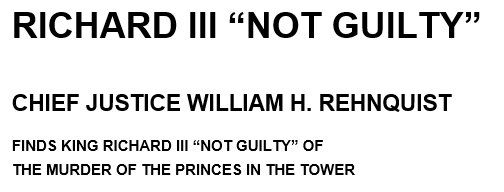 |
Rick
Archer's Note: William Rehnquist was
once Chief Justice of the United States Supreme
Court. They probably could not have found a
more prestigious man to preside over the mock trial
of Richard the Third. (link)A
three-judge panel chaired by William Rehnquist
found King Richard III not guilty of the murder of
his nephews, the famous “Princes in the Tower.”
“The
Trial of Richard III” took place before an
overflow crowd as part of the Rehnquist’s four-day visit to the Indiana
University School of Law in Bloomington. The
trial featured appellate-style briefs and arguments
by students and graduates of the Law School.
The date was October 26, 1996.
|
Richard III
was represented by John Walda, also a graduate of
the Law School, a partner in the Fort Wayne,
Indiana, law firm of Barrett & McNagny, and
President of the Indiana University Board of
Trustees.
The defense sought to cast
doubt on the prosecution’s evidence and to show that
others, such as Henry VII who killed Richard III on
Bosworth field, had a better motive and opportunity
to commit the crime.
In addition, Walda
noted that the case took place in the eyes of “500
years of pretrial publicity”.
“Relying
on William Shakespeare’s plays as to any element
of the state’s case is a little like relying on
Oliver Stone’s movie to prove the Kennedy
assassination. At least Stone was alive to
witness the events!”
(John Walda)
|
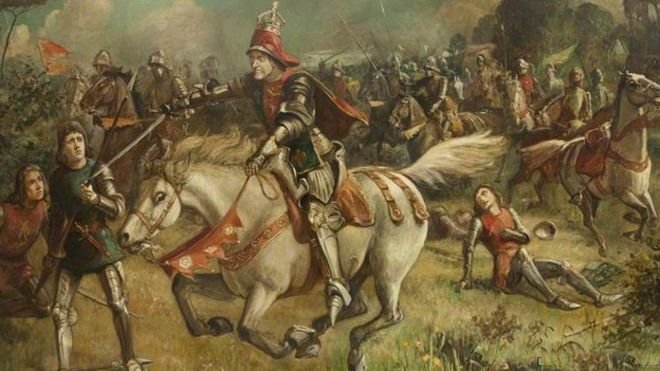 |
| |
|
Delivering his opinion at the conclusion of the mock
trial, Chief Justice William Rehnquist found that
there was too much “ambiguity as to when the murders
took place” to convict Richard III. “There is a
sufficient lapse of time even considering the
evidence most favorable to the State as to put it
beyond the time when Richard III was in control of
things and into the time when Henry VII was in
control of things,” the Chief Justice said.
The
Chief Justice also found that the “contemporary
accounts,” which tend to incriminate Richard III,
“are not worth much in a trial of this sort . . .
because they are not made with first hand knowledge;
they are kind of rumor on rumor . . . .”
|
| |
|
The three judge panel ruled Richard III not
guilty in a split decision. Joining Judge
Rehnquist in the not guilty verdict was moot
court judge, law school professor, Susan
Hoffman Williams.
The third judge, Indiana state Chief Justice
Randall Shepard, dissented with a guilty
verdict.
Shepard found that “as a matter of
historical judgment,” many of the
contemporary writers had “access to actual
participants in the drama of the time.”
Chief Justice Shepard also noted that “the
defense has had 500 years to find evidence,
actual evidence, as opposed to speculation,
that somebody other than Richard III was
responsible for these deaths and by and
large there isn’t any.”
As a result, Chief Justice Shepard said,
“This leads me to
the conclusion that Richard the Third is
guilty of murder.
Guilty, guilty,
guilty.”
|
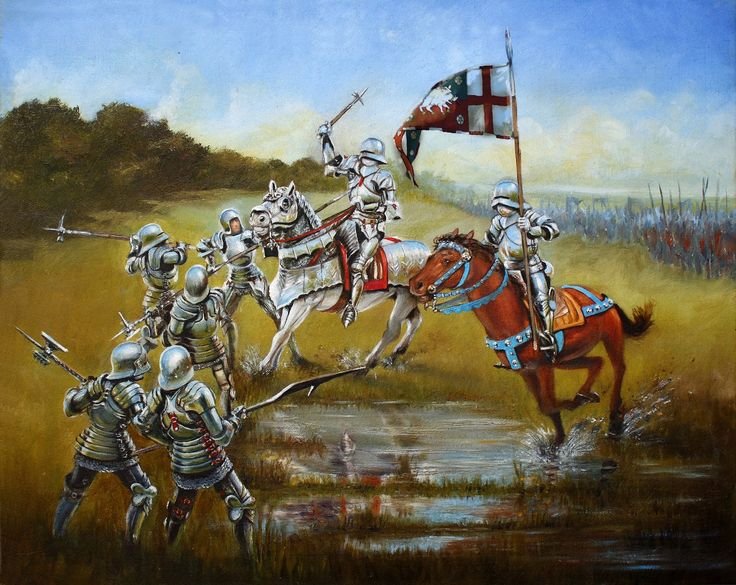 |
|
|
On the Open-Minded
Side...
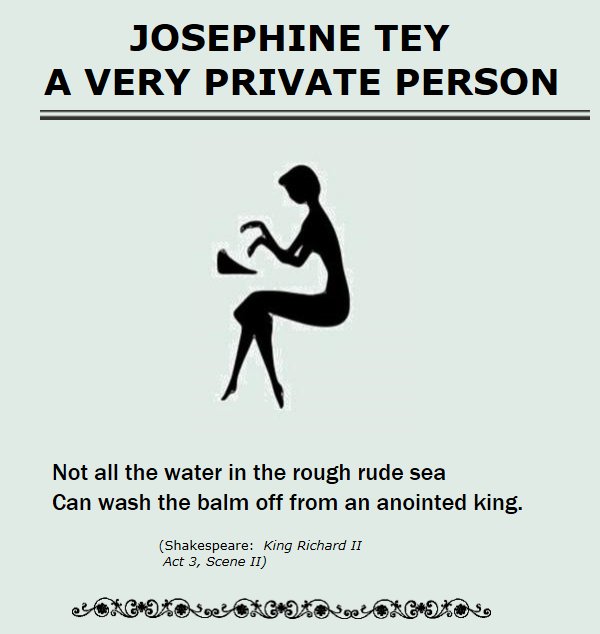 |
Rick
Archer's Note: Josephine Tey was the
pseudonym used by Elizabeth MacKintosh (1896–1952),
a Scottish author best known for her mystery novels.
Ms.
Tey's hero is Scotland Yard Inspector
Alan Grant, a sharp sleuth in the tradition of
Sherlock Holmes. Grant had his finest hour in
The Daughter of Time, written in 1951.
The
story begins with Grant laid up in hospital with an
injured spine. Bored out of his mind, Grant
becomes intrigued with the mystery of the
disappearance of the princes in the tower,
supposedly murdered by their wicked Uncle, King
Richard III. Curious about the monstrous crouchback of Tudor myth
and Shakespearean literature, Grant
decides to solve the mystery.
Not once
does he leave his bed. Instead, Grant has his
friends bring him reference books and contemporary
documents so that he can puzzle out the clues.
Working deliberately, he
determines whether King Richard III of England
murdered his nephews, the Princes in the Tower.
Grant comes to the firm conclusion that King Richard
was totally innocent of the death of the Princes.
The
fight against injustice was a prominent theme in
Josephine Tey's works. Here in modern times,
there is a sentiment that perhaps Richard got a bad
rap. What we do not know is where that
sentiment came from. Give Josephine Tey the
credit.
When Ms.
Tey's book came out, it flew straight in the face of
powerful public sentiment against Richard. All
by herself, Ms. Tey was able to reverse five
centuries of unanimous public censure.
After
her book appeared, not everyone agreed with her...
but they thought about it! The
greatest testimony to the brilliance of this work is
that for the very first time many eyes were now open
to the possibility that Richard might actually be
innocent.
In 1990, Daughter of Time
was selected by the British Crime Writers'
Association as the greatest mystery novel of all
time. It stands at #4 by the Mystery Writers
of America.
It was a
remarkable novel because it made an entire country
re-examine its previous attitude.
It is
said that the publication of this mind-bending book led to the
formation of The Richard III Society. Thanks
in large part to The Daughter of Time,
much scholarly debate has been done since in an
effort to present a more balanced account of Richard, the last Plantaganet king.
I would
like to add that without this book, questions about
the battlefield location and Richard's burial site
would probably never have been asked.
|
Rick
Archer's Note:
We have
come to the end of our saga. What a long
strange trip it has been.
At the
outset, I promised Brevity, but I failed miserably.
Oh well, let's face it, I got hooked.
According to that map, there were 15 major battles
fought during the 32 year Wars of the Roses
(1455-1487). Of those 15 battles, I wrote an
account of 8. Looking on the bright side, I could have written
about all 15 of the Battles. So I guess I did
show some restraint.
During
my research, I found a soul mate. Her name is
Jo Walton. Ms. Walton is an award-winning science
fiction writer who is also Josephine Tey's biggest
fan.
Here is
what Ms. Walton said about The Daughter of
Time:
This is a book about research. It’s the story
of chasing Richard through secondary sources and
primary sources and putting together the clues to
discover who really killed the Princes in the Tower.
Grant doesn’t get out of bed; a subordinate, a
friend, the nurses and a research assistant bring
him books and information.
He starts from a portrait of Richard and works
outwards from there. It’s either a very faithful
example of how writers do research or I learned how
to do research from reading this (I genuinely
wouldn’t care to guess which.)
The book isn’t perfect. There’s far too much of Grant’s
uncanny ability to read character from faces - which
one could argue makes it fantasy. There’s also far
too much of the Velikovskyan style of argument that
goes “The facts are A. Somebody did B. How could
anybody possibly do B when faced with A? We must
therefore have the facts wrong.”
I find no difficulty imagining people who do B.
Maybe I just have a wider imagination, or maybe I
get out more.
I have not independently investigated the argument
that Richard didn’t kill the Princes in the Tower.
It’s not my period of history. I’ve heard people
argue that Tey is cheating and leaving things out. I
honestly couldn’t say.
I find Tey’s Richard and Shakespeare’s Richard to be
interesting fictional characters, and the same goes
for John M. Ford’s Richard, who did kill the princes
in the tower but only because they were vampires…
and I think the relationship of all three of these
constructs to the bones they dug up in Leicester is
symbolic rather than actual.
But you cannot help thinking about it when you read
The Daughter of Time because
the real subject of this book is how a lot of
received history is sheer bunk.
At the very least, it causes the reader to
interrogate history instead of accepting it!
|
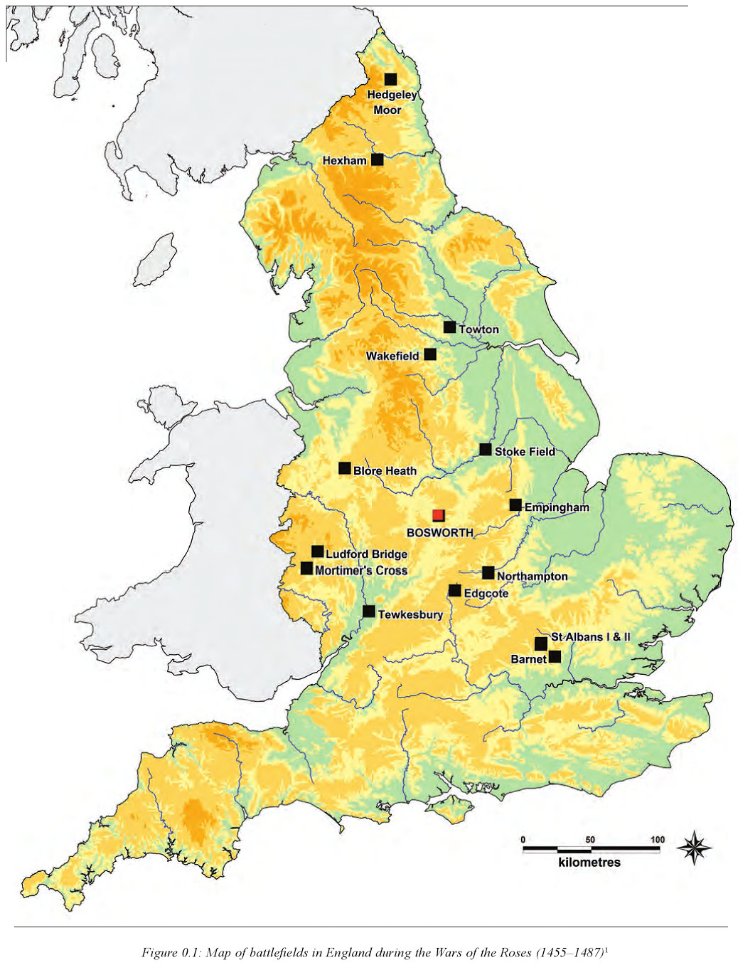
|
|
|
|
"At the very least, it causes the reader to
interrogate history instead of accepting it..."
(Jo Walton)
|
|
|
|
Sometimes other people say things that I wish I had said.
Jo Walton's comment is at the top of my list.
Elizabeth Aida Feola's comment is up there too:
"We
can make any statement we wish and stir up
doubt. In five years, students coming into
college courses will ask their professors about
how Richard was dropped as a baby. Enough years
go by, and it’s accepted as fact."
| |
|
John
Walda, the man who represented Richard III in the
mock trial presided over by Judge Rehnquist, also
made a comment that I wish I had said.
Mr. Walda noted that the
mock trial took place in the eyes of
“500 years of pretrial publicity”.
“Relying on William Shakespeare’s
plays as to any element of the state’s case is a
little like relying on Oliver Stone’s movie to prove
the Kennedy assassination. At least Oliver
Stone was alive to witness the events!”
For my younger readers, Mr. Walda is
referring to JFK, one of the
most controversial movies of all time.
John F. Kennedy's assassination remains
the great unsolved American mystery.
The anger came because Oliver Stone did a
masterful job of selling a rather
implausible
explanation. Mr. Stone was taken to
task for twisting the facts.
I do not know what was the truth, but I will
admit to feeling goosebumps while I watched
the conclusion.
|
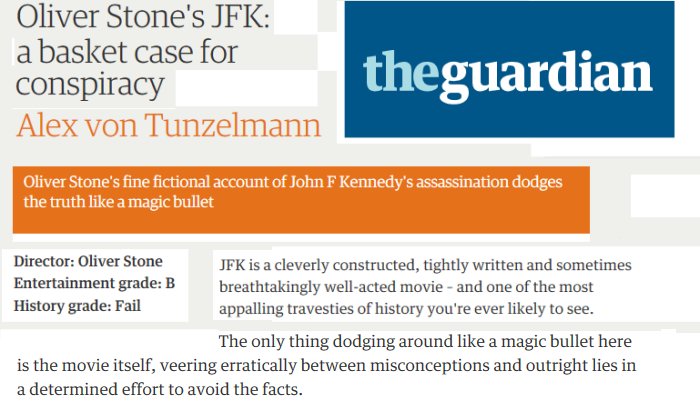 |
| |
|
At the
time of its release, the JFK movie
opened up a bitter fight, probably just as heated as
the argument over Josephine Tey's Daughter of
Time when it was released back in 1951.
If we stop and think about it, the controversy
surrounding the murder of John Kennedy is similar in
many ways to the controversy surrounding the murder
of the Princes in the Tower.
People
accused Oliver Stone of manipulating the facts,
which is why lawyer John Walda compared the
JFK movie to Shakespeare's Richard III
in the first place. Both works of art
were accused of spreading false information and
distorting the truth.
I am
ready to say the same thing about White Queen.
I resent this series for distorting the truth.
Recently
I took Marla, my wife, out to dinner. She
smiled and asked me to tell me a little bit about
what I had writing lately.
I
replied that I had been writing about the War
of the Roses.
Marla:
"You mean that TV show we watched last year with
that awful woman the Red Queen?"
I
grinned. "Yeah, that's it, Margaret Beaufort."
As a bit
of background, Marla could not stand the Margaret
Beaufort character. During the ten-week
series, Margaret was convinced it was God's Will for
her son Henry to become king. Strident, whining,
holier-than-thou, anytime Margaret wanted something,
she would fall to her knees and pray, then beg God
to show her a sign. Instantly the sun would
come out from behind a cloud and Margaret would go
nuts. She would throw herself to the ground
and begin crying with ecstasy. "Oh, thank you,
God, thank you! Thank you for answering my
prayers!"
Marla
absolutely could not stand the woman. She
hissed every time Margaret appeared. Nor did I
blame her. Amanda Hale's performance as the
Red Queen was wildly over the top.
That
said, I have a secret to share (psst... don't
tell Marla!). Personally, I enjoyed
watching Amanda Hale. What an amazing actress!
I didn't like her character in the White Queen
series, but I appreciated the job Ms. Hale did.
|
|
|
|
Marla: "Wasn't Margaret Beaufort the one who
murdered the Princes in the Tower?"
Rick: "Yes, but after the research I have done,
it seems unlikely that Margaret was behind the
disappearance of the two boys."
Marla: "You're kidding? I remember
Margaret's husband strongly suggesting those two
boys be eliminated. If so, her own son
Henry would have two less people in front of him
in line for the crown."
Rick: "I know, that's what the show led us to
believe. I was just as surprised as you
were when I learned differently. But some
priest had the two boys declared illegitimate.
That's how Richard was able to made king without
much of a fuss. If the boys were
illegitimate for Richard, then they would be
illegitimate for Henry as well. The TV
show got it all wrong. Margaret did not
murder those boys."
Marla: "I watched that entire show convinced
that pious Margaret was not only a murderer, but
the biggest hypocrite to ever walk the planet.
Why would the White Queen lie
about the facts so boldly?"
Rick: "There are reviewers who claim the
White Queen is methadone for
Game of Thrones junkies.
It doesn't
actually get you high, but it keeps you
watching the tube while you're
waiting for the new season.
Making up whoppers is good for ratings.
My guess is the TV writers don't believe
White Queen is sensational enough.
They decided it
would improve the script to make Margaret the
murderer. That way they could let
Elizabeth, the White Queen, create an epic storm
to retaliate against Margaret by ruining Henry's
rebellion. Why let the truth get in the
way of a good story? Hollywood has been
doing this for a long time, but Shakespeare did
it first."
Marla: "Why not just tell the truth? The
story was compelling enough without having to
resort to fiction."
Rick: "I could not agree more. I do
not think it is ethical to destroy Margaret
Beaufort's reputation just make the TV show more
compelling, but that small point doesn't seem to
stop people."
|
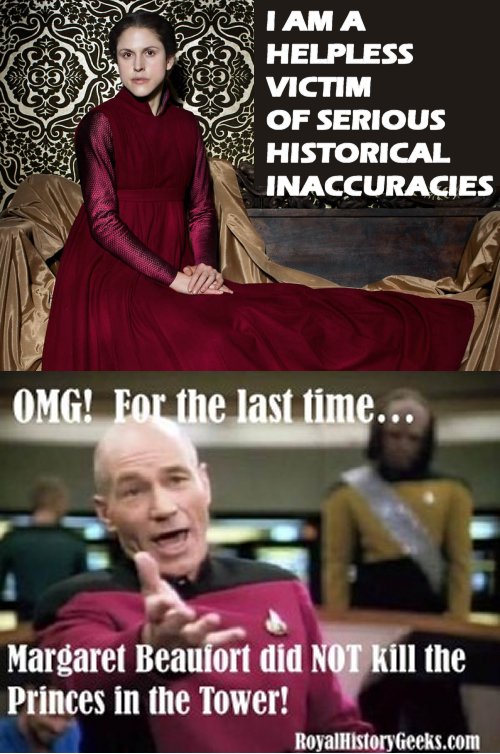 |
And now
it is time for Rick's Soapbox.
There
are a dozen different news sources on TV that slant
each story in the direction they believe their
target audience wishes to receive the news.
Flip the channel and you will receive a totally
different interpretation of each news story.
But why bother flipping the channel? If
a person sticks to one news source, they can spend
the rest of their lives being fed a biased,
one-sided reality that will never deviate from their
preferred political mindset.
If there
is one thing I learned in researching the story of
Richard III, it is that people lie. There are
some people... media, script writers, bloggers,
historical fiction writers, you name it... who lie
or twist the facts all the time if they think it
will be to their benefit.
Personally, I have no idea whether Richard III was
innocent or not. But I do know he was the
victim of the worst smear campaign in history.
I have no whether Elizabeth slept with her uncle or
not. But I can't help feeling like she was
unnecessarily smeared.
I
contend that just because we have the power to pass
on dubious rumors does not make it right. Is
Reality really that boring? Personally, I
think the War of the Roses is the craziest story I
have ever come across and yet people feel the need
to embellish it with incest. Why don't we stop
writing historical fiction and try writing
historical truth instead?
As my
final word, today
we are
immersed in times dominated by
Fake News
and Alternative Facts. Facebook has become
riddled with falsehoods. People can say
anything they want on Twitter with complete
impunity... and people will believe it because they
want to. The same goes for the Internet.
|
|
|
|
The
effortlessly-transmitted disease of gullibility is
pandemic. The only cure known to man is a
built-in bullshit detector. Buy one on Amazon.
However, if you can't afford one, try developing a
home-made version instead. It is called 'skepticism'.
If
you read or hear something that doesn't feel
right, be sure to check it out first before
passing it on. Nothing irritates me more
than people who preach their own reality without
bothering to question the source or the sense of
it.
In the words of Jo Walton... do not
simply accept what you read or hear, interrogate it!
Question
everything. Otherwise one day you will
discover you have been wandering around with
blinders on.
As for
me, the next thing I am going to do is order a copy
of The Daughter of Time for my Kindle.
I absolutely cannot wait!!
Thank
you for reading,
Rick Archer
February 2017
|
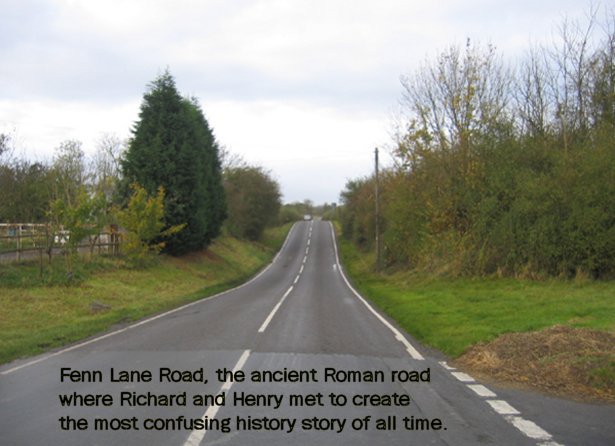 |
|
|